
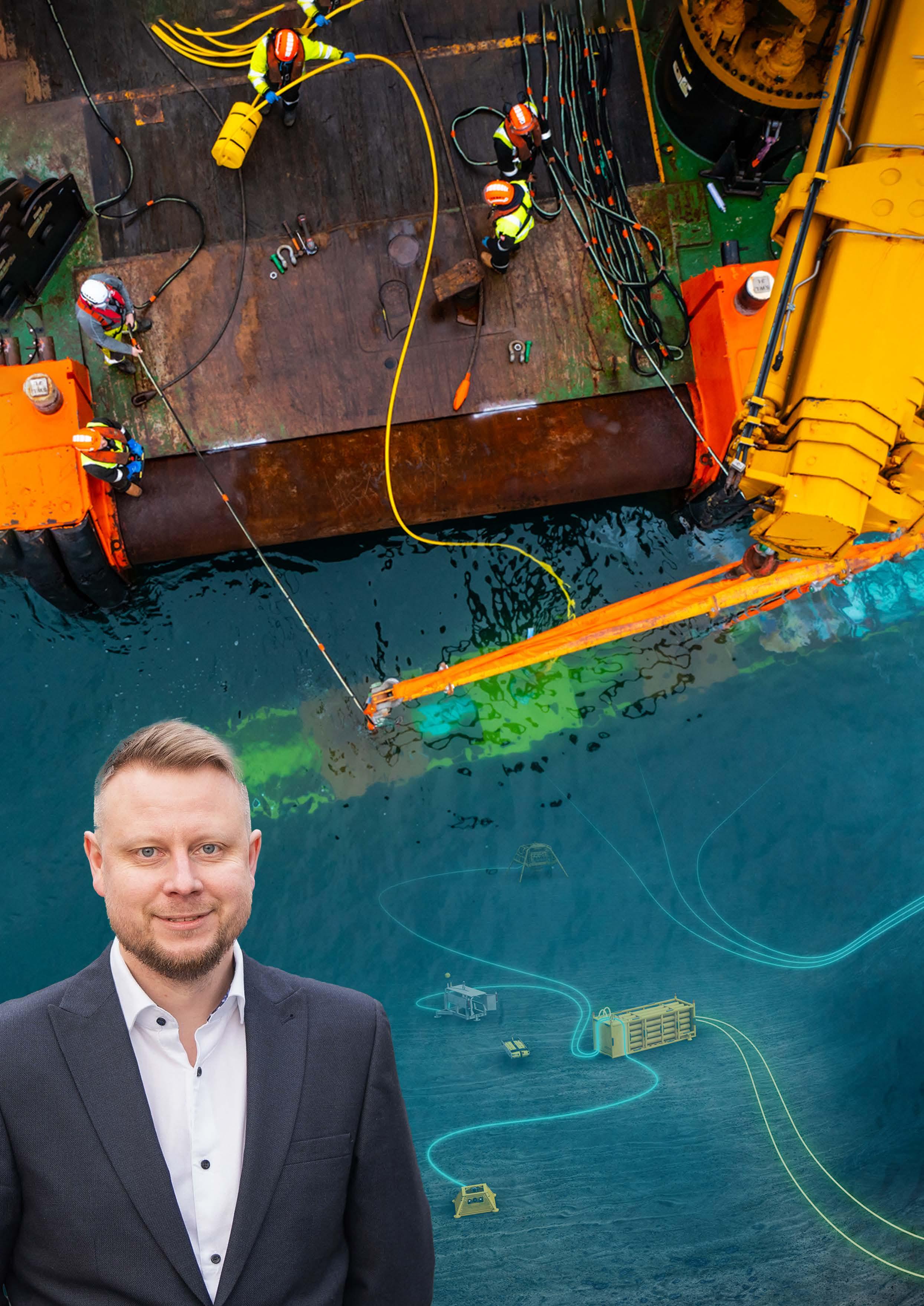



READ ONLINE AT COVER FEATURE VERLUME P.4-5 GLOBAL NEWS AREG P.8 Interviews With: UNIQUE GROUP P.18 THISTLE WIND PARTNERS P.20 PODCASTS WIND P.22 MARINE & TIDA L P.24 HYDROGEN & CCS P.26 GEOTHERMAL P.28 RENEWABLES PUBLICATION IN ASSOCIATION WITH READ ON PAGE 4 FEATURING GLOBAL NEWS PROJECTS MAP PODCASTS ❙ WIND ENERGY HYDROGEN & CCS GEOTHERMAL ELECTRIFICATION CONTRACTS ANALYTICS EVENTS
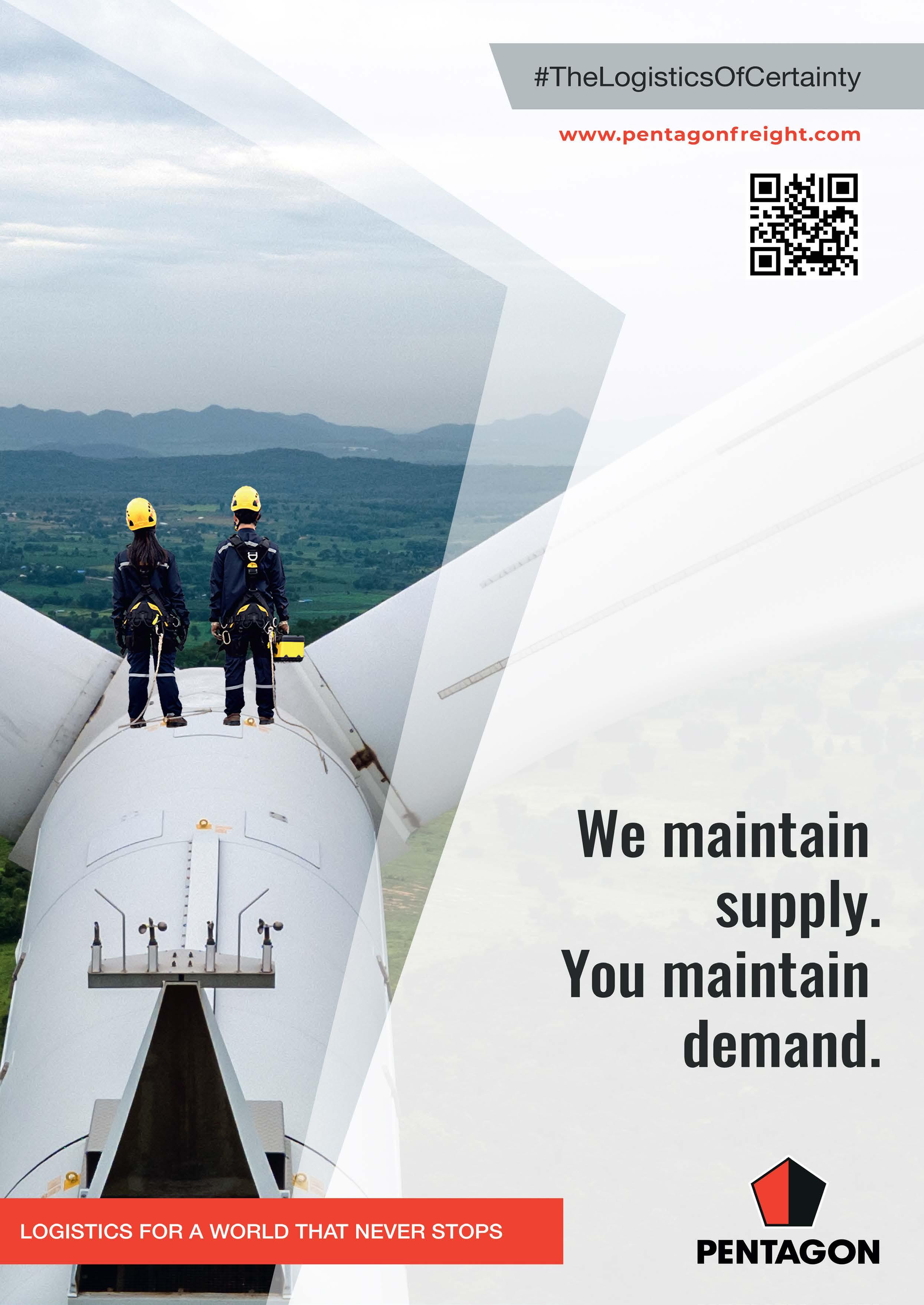


Dear Readers,
Welcome to the latest edition of ‘OGV Renewables Magazine’ where we explore the changing landscape of renewable energy and the ongoing energy transition. In this issue, we are thrilled to welcome Verlume as our front page partner and you can read all about how they are balancing offshore renewable power through subsea energy storage on pages 4-5 inside.
In this issue, we had the privilege of sitting down with Martin Charles - Chief Operating Officer at Unique group and discussing how they are utilising ROV’s, AUV’s and USV’s in the offshore wind, environmental monitoring and civil defence sectors, as well as growing their global footprint with new offices in various geographical areas.
We also hear from Pierre Pesnel & Ian Taylor at Thistle Wind Partners who shed light on their monumental Ayre and Bowdun projects and the implications for Scotland's renewable energy landscape as well as the potential export opportunity for Scotland that this expertise creates.
Mike Adams - CEO of Elemental Energies shares some fascinating insights on why Geothermal Energy is becoming an important part of the energy transition and how his organisation are helping to provide valuable expertise as the technology gains traction across the globe.
We also have articles relating to the latest news across Wind, Hydrogen & CCS, Geothermal and Electrification as well as analytics from Westwood Global Energy Group, project information from the EIC and contract wins from Infinity Partnership.
Warm regards,
Moray Melhuish
EVENTS P.4 P.8 P.16 P.18 P.22 P.24 P.26 P.28 P.30 P.32 P.34
COVER FEATURE GLOBAL NEWS PROJECTS MAP PODCASTS WIND ENERGY MARINE & TIDAL HYDROGEN & CCS GEOTHERMAL CONTRACTS STATS & ANALYTICS
WISH TO CONTRIBUTE TO OUR NEXT PUBLICATION? Contact us to submit your interest daniel.hyland@ogvenergy.co.uk
contents
MORAY MELHUISH – FOUNDER OF ANNET CONSULTING
3
Photo: Andreas Gücklhorn_Unsplash

BALANCING OFFSHORE RENEWABLE POWER: SUBSEA ENERGY STORAGE
Imagine a world where the vast expanse of the seabed isn't a silent void, but a bustling hub of communication, relaying critical data from the depths to the surface. This vision is becoming a reality thanks to innovative technologies like subsea energy storage from Verlume.
Moray Melhuish had a chance to catch up with Richard Knox, the company’s chief executive. As a business living at the intersection of the renewable energy storage, offshore wind, wave and subsea industries, Verlume is one of the most innovative energy transition businesses around.
Q: Richard, thanks for joining our podcast. Can you just introduce yourself please and tell us a little bit more about Verlume as well?
A: Of course. I'm Richard Knox. I'm CEO and the founder of Verlume. I'm a chartered mechanical engineer graduated way back in 1999. I spent most of my career prior to setting up Verlume working in subsea engineering, surrounded by yellow steel, subsea Christmas Trees and drilling equipment. Part of that journey gave me exposure to the offshore environment and an understanding of some of the potential energy that was out there. And I think this is what prompted me to set up Verlume - I was passionate about how we could take that learning experience and move it into the marine renewable energy space.
Q: Brilliant. Tell us a little bit more about the company’s history. How did you get where you are and what is the company's position on the energy transition?
A: Much of what we do stems from the experience that a lot of our team have had, including myself from subsea engineering, oil and gas, and then using that to the benefit of the renewable energy sector. Back when we started, there were a lot of companies trying to establish renewable energy power converters, and they went straight to grid. I thought that was the first example of any technology that's taking such a big leap. Nearly everything else has some form of stepping stone to get there. At the time, there was quite a lot of divisiveness around what's renewables and what's oil and gas. I’d even say there was hostility amongst those sectors, around using some of the experience from the oil and gas industry.
My idea was to see if we can find another path of building these technologies up to achieve
a more sustainable future with renewable energy in mind. I also realised very quickly that any application that wasn't going straight to grid needed some form of energy storage. It always needs to have power on demand. We’d consider tidal energy as it was the most predictable. We thought that if we could combine this with an energy storage system, this would be the best solution for providing power to applications on the seabed, like monitoring and data collection.
Q: And how did the business develop?
A: We managed to secure funding from Scottish Enterprise and then we got some external funding from Orchard Ventures. This allowed us to build our very first full-scale prototype, which was the world's first tidal energy system with integrated energy storage. It became clear through this process that the challenge had always been on the power generation side. We tried to take inspiration from the electric vehicle market and use it underwater. But since this was a completely different use case, it was super inefficient. We then realised that if we don't develop our own, the whole business isn't going to exist because this is so fundamental in what we do. We were also met with a little bit of pessimism from the industry initially and only when we presented the first working model in 2017 we completely changed the conversation. Once the companies started to supply us with data, we realised that the energy management challenge wasn’t specific to tidal, it was going to affect any renewable energy source. From that point on, we pivoted the business around energy management and storage, agnostic of how we store it.
Q: Understood. So with the company being now over ten years old, what kind of footprint does Verlume have?
A: We have two facilities in North East Scotland, an office and an operations facility. We also have sales support representation in the United States.
We have built our business to over 30 employees. We also have many positions currently open so there is very strong growth.

Q: Sounds like you’re going from strength to strength. And in terms of recent developments, we heard you have some exciting news?
A: Yes, there has been a lot happened within the last year. I think one of the biggest seeds for that was when we won the innovation competition with RWE. As I mentioned at the start, a lot of the work that we've been doing is around how you scale up to grid-scale. Recently in a Dutch offshore wind tender, the scoring system provided half the points for the system integration. In other words, how can you stabilise power while its offshore to make the whole system more efficient. After winning the competition, we worked with RWE on their bid and we secured the contract. That's going to be the world's first offshore battery connected directly to an offshore wind turbine. That's a really big contract and it’s given us the cornerstone for moving forward that side of the business.
At the same time we've also had a lot of success around the Renewables for Subsea Power project with Mocean Energy, so it has been a really good year for Verlume.
We have collaborated with the Net Zero Technology Centre, Harbour Energy, Serica Energy, Transmark, Baker Hughes, PTTEP the Thai national oil company and Shell Marine Renewable Program, so our expertise is becoming more recognised internationally.
And with TotalEnergies - who have been the driver of offshore electrification, subsea electrification, for decades – on board it is even more promising.
Q: Can you talk us through the Renewables for Subsea power system?
A: Sure. We've got the Mocean Energy wave energy conversion device that is generating the power. You've then got our Halo energy storage system storing the power on the seabed. The whole system is a power generation and communications portal, it’s effectively a power and communications microgrid that is created by adding the two elements together.
We are a leader in world-class intelligent energy management and storage technologies for decarbonisation of

COVER STORY
Visit at www.verlume.world 4 www.ogv.energy - Renewables Issue 7
the energy sector.

Q: Sounds very innovative. And why is subsea the right place to store the energy?
A: Well, it's not the obvious place and not many companies have looked there. Obviously it's handy for us due to our expertise, but there are a few advantages. For starters, the batteries are heavy so that’s a challenge when you try to put them at surface. Additionally, they perform best when they're kept at a stable temperature that the seabed offers.
With all the models we considered, it always comes out more cost-efficient to keep the energy storage on the seabed, with the batteries enclosed in pipes to keep them dry. Finally since we are skipping all the mechanical moving parts, we are keeping the maintenance costs to the minimum. Imagine being able to put the system out for ten years and not have to think about it.

A scalable, modular battery energy storage system with integrated intelligent energy management, specifically developed for the demanding underwater environment.
Storing the Juice:
Imagine a sleek, underwater device anchored to the seabed, nestled within the enclosure, lie lithium-ion batteries. These batteries play a crucial role, diligently storing the captured energy for future use. But why subsea? Unlike their surface-dwelling counterparts, these batteries thrive in the stable, cool temperatures of the ocean depths. No need for expensive climate control systems the seabed itself becomes the ultimate guardian, keeping the batteries safe and efficient.
A Gateway to the Deep:
But the story doesn't end there. This subsea enclosure is more than just a power bank; it's a communication portal. Embedded within its structure are fibre optic cables and sophisticated electronic modules, weaving a seamless connection between the seabed and the surface. Data collected by underwater sensors, from environmental monitoring to pipeline inspections, can now be effortlessly relayed upwards, providing invaluable insights into the hidden world below.
Benefits Abound:
This novel technology boasts a multitude of advantages. The subsea environment protects the equipment from harsh weather conditions, removing maintenance needs. The stable temperature optimises battery performance and extends their lifespan. And perhaps most importantly, it removes the need for bulky infrastructure on the surface, minimising both visual and environmental impact.
Powering the Future:
The applications of this technology are diverse and promising. Imagine powering underwater research equipment, remotely operating subsea robots, or even providing clean energy to coastal communities. At larger scales, the system can stabilise the power from offshore wind farms, contributing to a more sustainable energy mix.
Challenges and Innovations:
While the future looks bright, challenges remain. Scaling up the technology and optimising energy storage will be crucial for broader adoption. Additionally, navigating complex regulations and environmental concerns is essential for responsible development. However, with continued research and innovation, these hurdles can be overcome.
The Road Ahead:
The development of subsea energy storage and communication represents a significant leap forward in our relationship with offshore renewables. It reminds us that the vast, seemingly unassuming depths of the ocean hold immense potential, waiting to be harnessed for a better future. By embracing this technology, we can not only unlock a sustainable energy source but also gain a deeper understanding of the intricate world beneath the waves. So, the next time you gaze at the ocean, remember this – the power of the future might just be brewing in its depths.
COVER STORY
5
FIBRE OPTIC TRAINING for the onshore, offshore and renewables markets

RCP - Instrumentation and Control System specialists have made significant investment in fibre optic equipment such as fusion splicing machines, mechanical splicing kits, fibre optic ovens, optical power meters, optical microscopes and polishing equipment to terminate and test fibre optic cables, connectors, junction boxes and patch panels to a very high standard.
In 2021 a dedicated fibre optic workshop was set up at our Blackburn facility to provide fibre optic training to the onshore, offshore and renewables markets.
Fibre Optic Training includes
Fusion Splicing of single mode and multimode cables using Fujikura fusion splicers, construction of bespoke fibre optic cables and connector sets, construction of circular plug/socket connectors for hazardous area use. ATEX/IECEx zone 1 connectors, cables made up with pre-potted glands and tails to facilitate ease of fitment to drilling platforms, rigs offshore and renewable assets.
Mechanical splicing – Corning and Huber + Suhner connectors, ST, SC and LC, insertion loss and cable loss measurements, testing connectors and cables for insertion loss and return loss. OTDR testing using Fujikura machines.
The format of the course starts with the theory of Fibre Optics. Safety when using Fibre Optics, FO cable selection and connector types. Stripping fibre optic cables and
FIBRE OPTIC + TRAINING COURSE


preparation including the use of fan out kits, the use of fibre breakout boxes and fibre optic plug socket connectors and an understanding of loss budgets for fibre optics.
Delegates will learn how to manually splice using a Corning Kit with ST, SC and LC connectors. They will learn how to measure insertion loss of splices, connectors and cables. The delegate will use a fibre optic power meter. There will also be an introduction to fusion splicing.
The training course consists of both theoretical and practical elements with approximately 75% of the course being practical exercises where the delegates get to practice the skills taught.
By the end of the course each delegate will be able to identify different types of fibre cable for use on/offshore, select the correct type of cable and connector for the application in hand, prepare and manually splice a connector onto a fibre optic core(mechanical splice), test the integrity of the connector and measure the insertion loss of the cable or cable system.
For more information
The delegates will be able to fault find and repair fibre optic cables and connectors, prepare and splice a connector onto a fibre optic core known as fusion splicing.
The course material can be created bespoke to a company’s specific requirements. The course runs over 2 days.
A certificate of competence will be issued to the delegate's employing company on successful completion of the course.
RCP provide the following site services on or offshore
Fusion Splicing of single mode and multimode cables – Fujikura fusion splicers, Construction of bespoke fibre optic cables and connector sets, Mechanical splicing – Corning and Huber + Suhner connectors, ST, SC and LC. Construction of bespoke fibre optic cables and connector sets – Insertion loss and cable loss measurement, testing connectors and cables for insertion loss and return loss.
please contact us at www.rcpat.com
+44(0)1224
798312
I sales@rcpat.com


FINGERTIPS
DECADES OF INNOVATION & EXPERTISE IN ENGINEERING AT YOUR
INSTRUMENTATION & CONTROL SYSTEMS


www.renewableuk.com

RenewableUK members are enabling a just transtion to a net zero future. Focusing on continuous improvement around the three pillars of our Just Transition Tracker - People, Place and Planet These inspiring companies are a true showcase of the best that our industry has to offer.
Q&A: SHONA TEALE, OPERATIONS MANAGER AT ABERDEEN RENEWABLE ENERGY GROUP (AREG)
Shona Teale, Operations Manager at AREG, joined the not-forprofit membership organisation in November 2023 when it expanded its core team to meet the demand for member services. Now fully embedded in her role, Shona shares what led her to take up the position at AREG, what AREG can do to help accelerate the energy transition, and what its plans are for the year ahead.
Q. What led to you taking on your new role as Operations Manager at AREG and what were you doing before?
A. I was previously in the role of Project Manager in the Energy Transition Department at OPITO. During this time, I was involved in supporting and advancing the People and Skills plan for the North Sea Transition Deal. I worked closely with AREG and I really admired its commitment to driving renewable energy forward, so I was thrilled when I was given the opportunity to join the team and further immerse myself in the renewables sector.
Q. Can you tell us a bit more about AREG and its role in the energy transition?
A. AREG is 'the original energy transition organisation,' with a history that spans more than two decades. AREG champions the renewable energy sector, creating and disseminating opportunities for its members to engage in renewable projects through various channels, including member communications and ‘meet the developer’ webinars. One of AREG's key initiatives is its commitment to fostering cooperation among its members through its networking groups. At AREG, we recognise the power of collective action in addressing the complex challenges associated with the energy transition. By bringing together a diverse range of stakeholders, including industry leaders, government agencies, and technology innovators, AREG actively promotes a collaborative ecosystem that accelerates the adoption of renewable energy solutions.
Q. What will AREG be working towards in 2024?
A. AREG introduced a whole new team last year and we are now focusing on building relationships with members, creating more opportunities for collaboration, and enhancing our membership offering. We have a suite of network events and webinars planned throughout the year, designed to bring our members together to share insights and knowledge about the renewable energy sector.
Q. Do you have any advice for organisations thinking about joining AREG?
A. Reach out to us! We can arrange a call to discuss the benefits for your organisation - these include gaining access to opportunities to build relationships and industry connections, receiving insider knowledge about the sector, and accessing networking and funding opportunities.
Q. Looking to the year ahead, what issues and opportunities do you think the energy sector will face in 2024 and how is AREG best placed to help?
A. One pressing challenge is the persistent skills and talent shortage in the energy industry. The rapid shift towards renewable energy sources demands a workforce with specialised skills. AREG has strong relationships with key industry stakeholders to facilitate upskilling initiatives and connect industry players, educational institutions,

and professionals to bridge the skills gap. The delicate balance between energy security and accelerating the development of renewables also remains a complex issue. AREG, as an organisation committed to the energy transition, fosters discussions among industry leaders and experts to formulate strategies that ensure a reliable energy supply while expediting the transition to renewables.
Other significant issues facing the sector include the financial landscape, changes to government policy and infrastructure and grid modernisation. AREG facilitates five networking groups, which cover topics such as public policy, supply chain and technology and professional services to provide a platform for knowledge exchange and the sharing of up-to-date news and developments on funding and grant opportunities.
We always seek to highlight and address relevant issues and concerns in the industry, to support our members, and help accelerate the energy transition. With our large network, strong industry connections and extensive knowledge base, AREG is uniquely positioned to support its members and help them tackle a wide range of challenges.
Q. How can people interested in joining AREG find out more?
A. They can visit our website for more information and to enquire about membership they can contact the team at info@aberdeenrenewables.com.
global news
CORPORATE PARTNER
8 www.ogv.energy - Renewables Issue 7

UK ALLOCATES £800M TO OFFSHORE WIND AR6 BUDGET
Offshore wind lands majority of London's largest ever auction cash pot
The UK will offer a record £800m to support new offshore wind farms in its upcoming AR6 budget.
The Department for Energy Security and Net Zero (DESNZ) confirmed that a total of £1bn will be set aside for the budget, with the lion’s share going into Pot 3 to develop offshore wind projects.
This represents a trebling of the size of the support package since last year’s CfD round failed to attract any bids from offshore wind developers amid concerns that the prices offered (capped at £44 per megawatt-hour) were too low.
The increased support will enable the UK for offer a higher price ceiling of £73/ MWh to developers after Energy Secretary Claire Coutinho and her officials increased administrative strike prices last year.
In addition, a £10m ringfenced funds for tidal stream projects will be available for a third consecutive year. The Administrative Strike Price has increased for tidal stream by 29% to £261/MWh and 5% for wave energy to £257/MWh.
The total budget for Pot 2, where tidal projects will compete, has also been increased from £35m in 2023, to £105m in 2024.
CEO of ScottishPower Keith Anderson said: “The UK has been a global leader in developing renewables. After the failure of last year’s auction to attract any bids for new offshore projects, today’s announcement is an important test of the government’s resolve to get back on track with its own green energy targets.
“The government has taken a major step in the right direction today by quadrupling the available budget – a clear statement of intent in ramping up the ambition to bring cheaper, greener energy onto the system quickly.
“I expect the auction to be hugely competitive. Given the scale of the available pipeline, there is always the opportunity to go further, and so we would encourage the Government to revisit the budget in the light of developments.”
Scottish Renewables CEO Claire Mack added: "Scotland's renewable energy industry welcomes today's announcement. However, the funding allocated to offshore wind is not fully aligned with the increase in deployment required to meet the UK Government's stated ambition of deploying 50GW by 2030.
"Industry was seeking a budget and framework that would repair the damage to the UK pipeline from last year's empty offshore auction. We continue to urge ministers to work with industry in the months ahead to ensure this is delivered so that the AR6 budget matches the enormous economic potential of all renewable energy technologies."
Energy UK Chief Executive Emma Pinchbeck said: “The government has listened to the energy industry about the need to deliver on the country’s ambitions for low carbon power with plans to deliver greater capacity from established renewables technologies like solar, onshore and offshore wind, as well as investing in new, emerging technologies like tidal, geothermal and floating offshore wind.
“It's particularly welcome that the government has recognised the economic and market conditions facing offshore wind developers. A big increase in the budget for AR6 means investing more in homegrown sources of clean power that will bolster our energy security and reduce emissions – and bring wider economic benefits across the country.
“While we still face an uphill battle to meet the 2030 target for 50GW of offshore wind, today has sent out an important signal in the face of growing international competition for investment and will help re-establish the UK as a leader in offshore wind.”
However, the Association for Renewable Energy and Clean Technology (REA) said it was disheartened by the lack of sector wide measures introduced by Chancellor of the Exchequer Jeremy Hunt in today’s Spring Statement.
Frank Gordon, Director of Policy at REA said: "This is a political budget above all that does not reflect the urgency of Net Zero and while we welcome the CfD budget announced alongside the Spring Statement today, and extension of the windfall tax on oil and gas excess profits, this is disappointing overall.
“In particular, the Chancellor had promised the sector a response to the US investment in green supply chains and manufacturing at the last fiscal event and to see very little once again on how we can ensure the UK does not miss out on the vital green jobs and investment up for grabs is very disappointing."


global news Renewable News SPONSORED BY
9
NEW DEAL SIGNED FOR OFFSHORE WIND INNOVATORS TO CONTINUE DRIVING FORWARD SOLUTIONS IN REAL-WORLD CONDITIONS
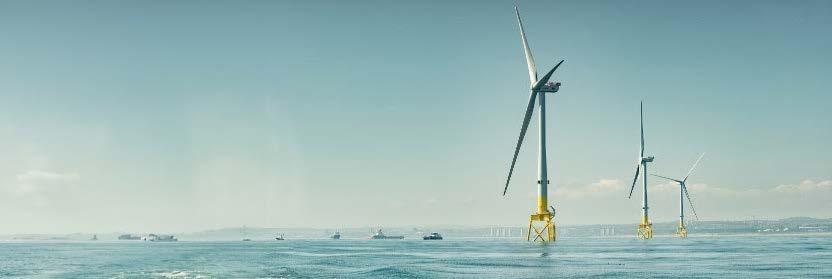
The Offshore Renewable Energy (ORE) Catapult and Vattenfall have signed a three-year extension on their testing and demonstration collaboration at Aberdeen Offshore Wind Farm.
The partnership at the 96.8MW offshore wind test and demonstration facility first began in 2019. Since then, technologies which have the potential to address operation and maintenance challenges currently facing offshore wind farms have been tested at the site, such as blade repair, leading edge erosion, robotics, remote cable monitoring and remote and autonomous inspection. Now, more companies ready to test their technologies offshore will be supported by ORE Catapult and Vattenfall at the 11-turbine wind farm, 2.5km off the Aberdeen coast, until the end of 2026.
Hugh Riddell, Regional Partnership Manager at ORE Catapult, said: “Extending our collaboration with Vattenfall gives innovative UK companies a unique opportunity to deploy, test and demonstrate their technology in a real-world environment at Aberdeen Offshore Wind Farm.
“The UK is internationally recognised for technological innovation, but there is a need to fast track the commercialisation of these technologies and boost supply chain opportunities in the years to come. De-risking their innovations on an operating offshore wind farm in the north east of Scotland, which is already home to so many innovative engineering companies, will help to accelerate routes to market, increase confidence for potential customers, and further support the growth of offshore wind as part of the race to Net Zero.”
Lisa Christie, UK Country Manager at Vattenfall said: “As a leading developer of offshore wind, the collaboration between Vattenfall and ORE Catapult at Aberdeen Offshore Wind Farm is absolutely vital. We’re supporting technologies needed to promote a competitive offshore wind industry, strengthen the supply chain, and bring economic benefits to the UK.
“What we offer companies is a world class testing and demonstration facility. Technologies must meet the highest requirements – delivering increased safety in offshore wind operations, minimising impact on the environment, and reducing costs of renewable energy.
“We look forward to continued working with ORE Catapult to provide a test bed for exciting innovations that address the challenges facing offshore wind as we push toward net zero.”
Geo-data specialist Fugro completed the world’s first fully remote ROV inspection of an offshore wind farm at the Aberdeen site last year. Their uncrewed surface vessel (USV), Blue Essence® and electric remotely operated vehicle (eROV), Blue Volta® delivered an in-depth inspection, with the crew safely onshore. Real-time data was streamed via high band width VSAT connection to Fugro’s remote operations centre (ROC) in Aberdeen, improving safety and reducing carbon emissions by 95%. Since then, Fugro have expanded their USV fleet in Europe, completing multiple pipeline inspections and further windfarm asset integrity surveys.
Safety at sea pioneers Zelim tested their Swift Rescue Conveyor System which demonstrated it was 20 times faster at recovering people overboard offshore than any conventional systems, and Pegasus Welfare Solutions (PWS) constructed the world’s first in-turbine toilets that have been installed into all the wind farm’s turbines. PWS was acquired by OEG Offshore in 2021.
Faye McFarlane, Business Development Manager for Portable Welfare at OEG Renewables, said: “We are extremely proud to have installed the world’s first in tower toilets on each turbine at Aberdeen Offshore Wind Farm. The welfare units were transferred via crew transfer vessel (CTV) to the turbine where they were then lifted and put into position by the on-site technicians. Installing these units has been an important step forward for acknowledging the importance of welfare and safety of personnel offshore.
“Having the option to use a toilet inside the turbine reduces the number of vessel transfers for comfort breaks which, in turn, also increases productivity as less time is wasted with multiple transfers. By allowing for personal privacy these in tower toilets help to increase diversity in offshore wind.”
Edinburgh based company, Cyberhawk conducted an automated drone blade inspection at the offshore wind farm.
Euan Baird, Utilities and Renewables Lead at Cyberhawk, said: “Having a test site for companies to validate their technology in a real-life environment is vital for developing
solutions supporting the journey towards net zero. ORE Catapult and Vattenfall coordinated a demonstration for Cyberhawk to fly Sulzer Schmid’s cutting-edge drone-based blade inspection technology at Aberdeen Offshore Wind Farm. While we knew the technology was effective onshore, there are so many new variables and challenges in the offshore environment from the size of the turbines to the movement of the vessel, which are impossible to replicate in onshore testing.
“For Cyberhawk, having the facilities to get hands-on with the technology and validate its performance offshore was extremely valuable. Safety is our priority and having used the autonomous technology at Aberdeen, seeing it perform and validating the results, gave us the confidence we need to take it to market and offer these inspections to our customers. Together, Sulzer Schmid and Cyberhawk now offer efficient and reliable offshore wind turbine inspections in the UK offshore market.”
Nick Simmons, Director USV and Remote Working at Fugro stated: “This was a landmark moment for offshore operations and demonstrates how remote technologies are bringing significant benefits to the offshore wind industry. At Fugro it is important to us to create a safe and liveable world for future generations, our USVs are just one of many innovations we are leveraging to do this. Being able to test innovations like this at the Aberdeen Offshore Windfarm allows us to prove to the industry that the technology not only works but has the ability to completely transform offshore operations going forward, reducing carbon emissions and improving the safety and efficiency of operations, improving safety and efficiency of operations.”
Future projects at the wind farm will be looking at technology innovation in the areas of robotics and sustainable solutions.
Each year, Aberdeen Offshore Wind Farm offsets an average 134,000 tonnes of CO2 and meets the power needs of 80,000 UK households.


Renewable News SPONSORED BY
global news 11

UK REVIEW
UK LOOKS TO ACCELERATE ENERGY TRANSITION DESPITE CHALLENGES
By Tsvetana Paraskova
Despite recent challenges in the global and UK renewables supply chains, the UK has a chance to accelerate the pace of energy transition, secure a record number of offshore wind farms in the 2024 auction, and boost other clean energy rollouts, with supportive policies.

Renewable Power Generation Continues to Rise
The UK’s renewable electricity generation grew by 7 percent in the third quarter of 2023 compared to the same period of 2022, due to increases in capacity, up 5 percent, and more favourable weather conditions, the latest UK government data show.
As a share of total generation, renewable generation increased to 44.5 percent, outpacing fossil fuel’s share for the fourth consecutive quarter, the UK Department for Energy Security & Net Zero said in its quarterly Energy Trends report.
During the third quarter of 2023, energy production from renewable assets increased, with wind, solar, and hydro output up by 17 percent.
Overall, low-carbon sources – which include nuclear – generated 60.1 percent of the total electricity in Q3 2023, up by 9.9 percentage points compared to Q3 2022. This reflects higher renewable generation, up 6.8 percent compared to the same period in 2022 at 30.1 TWh, driven by a large increase in generation from wind, the government data showed. At the same time, fossil fuels generated 25.0 TWh, which was the third lowest quarterly value on the published data series and 31 percent lower than the same period of the previous year.
Policy Uncertainty
While power generation from renewables from newly installed wind farms is on the rise, the UK’s energy policies have been the focus of media and analyst attention at the beginning of 2024.
Labour’s plan to scrap a pledge to spend £28 billion annually on green energy raised concerns about the pace of the UK’s energy transition. Labour is polling ahead of Conservatives to win the election later this year.
The UK Sustainable Investment and Finance Association (UKSIF) said, via Chief Executive James Alexander, that Alexander added, “That said, the furore about Labour’s commitment on £28 billion of public investment has very quickly become a distraction when the real prize is to attract hundreds of billions in private capital.”
“Public funding of course makes a difference, but policymakers must remain clear-eyed about the much greater quantity of private capital available to help the UK reach net-zero,” Alexander noted.
At the end of February, UKSIF, which brings together more than 300 members managing over £19 trillion in global assets under management, warned in a report that 63 percent of UK energy companies have moved, or plan to move, investments out of the UK to a market more supportive of their sustainability goals.

“Furthermore, failing to implement new favourable policies could see the UK fail to benefit from a potential £115 billion of investment which is waiting to be unlocked for the UK energy sector,” the association said.
UKSIF polled 100 business decision makers across the UK energy sector, representing £700 billion in turnover, on their views about the current opportunities and challenges of decarbonising the UK energy system. Nearly nine in ten, or 87 percent, of UK energy businesses said that changes to UK policy are essential to make the UK an attractive investment location for green energy. In addition, 81 percent of large UK energy companies agree that the UK is falling behind other countries in the race to become the most investible market for low-carbon energy.
UKSIF’s Alexander called for practical and cost-effective measures that will advance the transition to a green economy and bring direct benefits to both consumers and the UK economy.
“Not only do we see no excuses not to accelerate these, failure to do so limits the UK’s growth potential, will continue to cause costs to consumers and threatens the UK’s position as a world leader in green finance and the undisputed financier of the net zero transition,” Alexander noted.
GLOBal news - uk review
12 www.ogv.energy - Renewables Issue 7

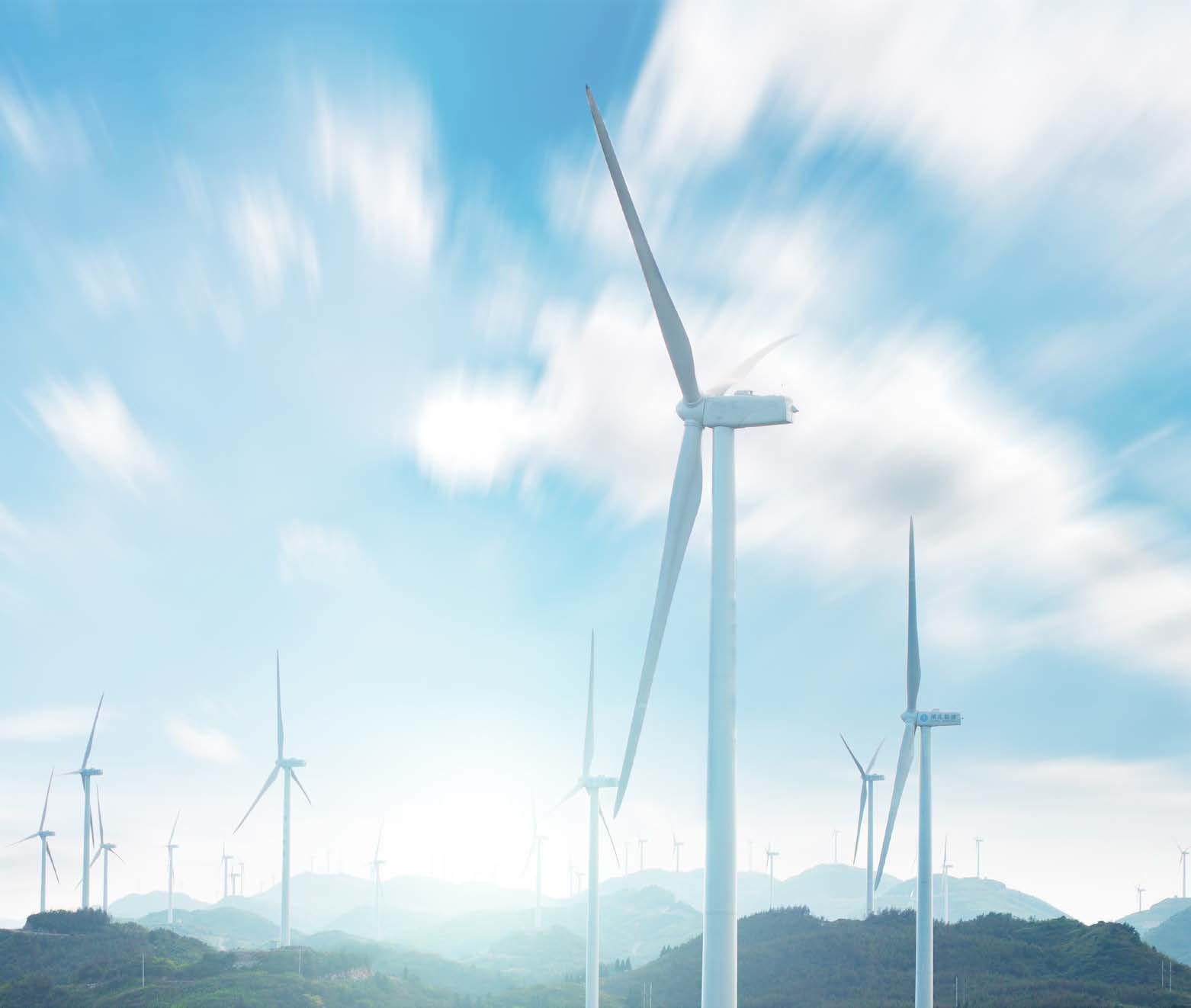
UK Net-Zero Economy Grows
The UK’s net zero economy grew by 9 percent in 2023, with the total gross value added (GVA) by businesses involved in the net zero economy now at £74 billion, non-profit organisation Energy and Climate Intelligence Unit (ECIU) found in a report published at the end of February 2024.
The 9-percent growth in the UK net-zero economy was much higher last year than the overall UK economy, which managed to eke out mere 0.1 percent GDP growth in 2023.
The net-zero businesses – including renewables, carbon capture, and green finance, as well as in more traditional and established sectors such as manufacturing –contributed £74 billion in Gross Value Added (GVA) in 2022-23, which was equivalent to 3.8 percent of the UK economy and was larger than the economy of Wales, £66 billion, ECIU said in the report it has commissioned with analysis provided by CBI Economics and The Data City.
These businesses also supported 765,700 Full Time Equivalent (FTE) jobs, equal to nearly 3 percent of total UK employment, the report found.
The analysis of the data showed that net zero jobs are better paid by almost £10,000— the average net zero salary being £44,600 compared to the UK average of £35,400.
A total of 65 percent of the top 25 net zero hotspots and half of the top 50 net zero hotspots in England and Wales are classified
as key electoral battlegrounds heading into the general election. Moreover, Conservativeheld electoral battlegrounds are found to be more than three times more likely to be areas of extremely high net zero economic activity, ECIU noted.
RenewableUK’s Director of Strategic Communications Nathan Bennett said, commenting on the report,
“This report makes clear that in places like Grimsby, Blyth, Hull and Barrow which are hubs of the offshore wind sector, and Sheffield where we have a growing green hydrogen industry, people now have lived experience of the benefits of clean energy investment in their communities - and that voters may consider this at the ballot box this year.”
“The UK also has an opportunity to unlock billions of pounds in further green investment by the private sector, and create thousands of new high-wage jobs..."
“As many of these areas are marginal constituencies, we may see each party’s policies on green growth making a considerable difference to the outcome of the next election,” Bennett added.
“The UK also has an opportunity to unlock billions of pounds in further green investment by the private sector, and create thousands of new high-wage jobs, particularly if the
Government encourages the growth of innovative technologies like floating wind and tidal stream, and nurtures UK supply chain companies which provide components and services for clean energy projects here and abroad.”
UK Offshore Wind Could Rebound, with Supportive Policy
The UK Government has an opportunity to secure a record number of new offshore wind farms, and record amount of new capacity, in the summer 2024 auction for contracts to generate clean power, the so-called Contracts for Difference, RenewableUK said in a report at the end of February.
“In a huge boost to the UK’s energy security, the Government has the potential to double the country’s offshore wind capacity in this year’s auction alone,” the renewables association said, noting that its latest EnergyPulse Insights Offshore Wind report found that 14 wind farms are already eligible to bid into this year’s CfD auction (Allocation Round 6), providing nearly 10.3 GW of new capacity. The previous records were set in 2022 when 8.5 GW was eligible across 7 projects.
Moreover, a further 4.7 GW of new offshore wind capacity – out of 8.7 GW in the planning system – could also become eligible before applications open for AR6 at the end of March, RenewableUK says.
If these projects were to receive consent from the Government, 14.9 GW of offshore wind capacity would be eligible for the 2024 auction.
“The Government is due to set out the overall budget and parameters for this summer’s auction next month, so RenewableUK is calling for Ministers to aim high to maximise the amount of capacity we can secure,” RenewableUK said.
Separately, industry body Scottish Renewables called on the UK Government to act now if Scotland is to unlock its world class pipeline of offshore wind projects in line with its climate ambitions.
In a letter to Secretary of State for Energy Security and Net-Zero, Claire Coutinho, Scottish Renewables has urged the UK Government to maximise the number of offshore wind projects capable of being successful in winning contracts through this year’s CfD allocation round.
After last year’s failure of the auction to attract any offshore wind bids, the renewable energy industry believes that at least 10 GW of offshore wind projects need to be successful in AR6 for the UK to remain on track for its 2030 target, Scottish Renewables said.
“Now is the time to incentivise investment in Scotland’s offshore wind sector, bolster domestic supply chains and supercharge the world class offshore wind pipeline that is set to power our net-zero future,” said Claire Mack, Chief Executive of Scottish Renewables.


GLOBal news - uk review Renewable News SPONSORED BY
13
The organisation also urged the Commission to develop and release an Electrification Action Plan within the first 100 days of its new tenure.
“Such a plan will provide the clear signal needed by public authorities, investors and consumers, facilitating a smooth transition in a fair, cost effective and competitive way. We welcome the Commission’s commitment to set a firmer European agenda for sustainable industry that will attract investment in Europe,” the Alliance said.
EU Finalises the Net-Zero Industry Act
The Council and the European Parliament reached a provisional deal in early February on the regulation establishing a framework for the ‘net-zero industry act’ (NZIA). The act is aimed at boosting the industrial deployment of net-zero technologies needed to achieve the EU’s climate goals, using the strength of the single market to reinforce Europe’s leadership in industrial green technologies.
The net-zero industry act aims to facilitate investment in green technologies, by simplifying permit-granting procedures and supporting strategic projects. It also proposes to ease market access for strategic technology products, enhance the skills of the European workforce in these sectors, and create a platform to coordinate EU action in this area.
SolarPower Europe’s Policy Director Dries
Acke commented on the provisional agreement,
“Landing the Net-Zero Industry Act is a crucial landmark in Europe’s clean industry story. It’s an essential piece of the industrial strategy puzzle, which will substantially improve offtake visibility for EU solar manufacturers at this critical time.”
“But let us be very clear: while landing the NZIA sends a strong signal to EU solar manufacturers, it doesn’t negate the need for emergency support,” Acke added.
“Manufacturers have weeks left of survival, this emergency requires urgent action from EU and national authorities.”
“EU Could Miss 2050 Climate Targets without Urgent Action”
Without urgent action, the EU is set to miss its 2050 targets by a decade, Wood Mackenzie said in a report at the end of February.
As the EU focus is shifting toward energy security and economic stability, the EU will not meet its targets until well into the 2060s if it doesn’t take urgent action to accelerate nascent technologies including green hydrogen and carbon capture, storage, and utilisation, according to WoodMac.
While the uptake of renewables and electrification is due to progress steadily, technologies such as hydrogen and CCSU need urgent action in the forms of investment, demand certainty, and policy commitment, according to the report.
The good news is that the EU’s ambitious legally binding goals are prompting the bloc to double down on efforts to streamline policy and strengthen cross-border infrastructure for power, carbon capture, and low-carbon hydrogen, said Lindsey Entwistle, senior research analyst at Wood Mackenzie, and lead author of the report.
“Targeted investment in these areas could accelerate the EU’s transition and achieve net zero by 2050,”

“Targeted investment in these areas could accelerate the EU’s transition and achieve net zero by 2050,” Entwistle added.
Solar Power Growth Set to Shine in 2024
Europe’s solar photovoltaic (PV) energy is set to jump by about 50 terawatt-hours (TWh) in 2024 – growing for the first time more than any other generation source – thanks to major capacity installations led by Germany, Rystad Energy said in a February report.
This year, wind power generation is also expected to rise, but the growth rate will not match the one seen in 2023, when wind energy output jumped by 50 TWh due to additional capacity installations and a windier year, particularly in the last quarter.
Germany is set to take the lead in the European solar power market adding more capacity than any other country in 2024, continuing the trend of 2023.
Moreover, this year is set to witness a significant improvement in solar radiation, marking a return to the norm after a relatively poor showing in the previous year, Rystad Energy reckons.
“As the demand for power in Europe is only growing slightly, we can conclude that Europe is fulfilling its electricity demand growth entirely with renewable sources,” said Vegard Wiik Vollset, Head of Renewables & Power EMEA Research at Rystad Energy.
“This indicates that the growth of renewable energy is more than sufficient to cover the growth in demand, which is why we are observing a decline in the use of fossil fuels.”
EU’s 2030 Wind Power Target Could Be within Reach
In wind energy, the EU built 17 GW of new wind capacity in 2023, slightly up compared to 2022 to a record-high for any year, but still not enough to reach the EU’s 2030 targets, WindPower Europe said in January. The EU should be building 30 GW of new wind every year until 2030 to reach its wind power installation target.
In February, WindEurope said that the recent uptake in permitting and investments brings the bloc’s 2030 wind target within reach.
In its annual statistics and seven-year outlook, WindEurope forecasts that the EU will install 29 GW a year on average in the period 2024 through 2030. This will bring the EU’s installed wind capacity to 393 GW in 2030, compared to the 425 GW needed to deliver Europe’s climate and energy targets.
While two-thirds of new installations will continue to be onshore by 2030, offshore wind installations are set to rapidly pick up towards the end of the decade, and new offshore installations will be almost the same as new onshore capacity additions in 2030, the association noted.
Improvements on project permitting, higher investments, greater certainty on the electricity markets, and the support to the wind industry at EU and national levels are all making the outlook on wind energy brighter than it was last year, WindEurope says.
“Things are looking up again for wind in Europe”, WindEurope CEO Giles Dickson commented. The improved permitting, rising investments, record volumes auctioned, and government support have helped the wind industry to begin recovering, he added.
“Europe’s wind supply chain is returning to profit and building the new factories needed to deliver the EU’s targets,” Dickson said.
“We’re now confident that we can get close to the EU goal that wind is 35% of electricity by 2030, up from 19% today – provided Europe accelerates the build-out of grids to connect all the new wind farms.”


GLOBal news - european review Renewable News SPONSORED BY
15

www.eicdatastream.the-eic.com
Energy projects and business intelligence in the energy sector
The EIC delivers high-value market intelligence through its online energy project database, and via a global network of staff to provide qualified regional insight. Along with practical assistance and facilitation services, the EIC’s access to information keeps members one step ahead of the competition in a demanding global marketplace.
The EIC is the leading Trade Association providing dedicated services to help members understand, identify and pursue business opportunities globally.
It is renowned for excellence in the provision of services that unlock opportunities for its members, helping the supply chain to win business across the globe.
The EIC provides one of the most comprehensive sources of energy projects and business intelligence in the energy sector today.
RENEWABLE PROJECTS

1
Botley West Solar Farm UK
$600 million
Photovolt Development
Partners
Development of a 840MW solar farm which will be split across three site areas located within Cherwell, West Oxfordshire and Vale of White Horse in Oxfordshire, England.
The second consultation has been concluded for the project and hoping to submit a Development Consent Order in the summer for 2024.
2
Offshore Wind Farm Blekinge SWEDEN
$3 billion
NTR plc
Development of a 1GW offshore wind farm located near Sölvesborg off Blekinge in southeast Sweden. An application for an environmental permit has been submitted to the Land and Environment Court in Växjö. A second one, requesting seabed investigations and laying underwater cables, was sent to the Ministry of Climate and Enterprise. Eolus stated that these applications, along with an environmental impact assessment and accompanying investigations, will undergo consultation with stakeholders before a permit decision is made. Upon approval, construction work for the project is expected to commence in 2027.

Onshore Wind Farm Pahkowski FINLAND
$350 million
Ilmatar Energy
Development of a 200MW onshore wind farm, at Pahkakoski, in Ii, Finland. The site will comprise of up to 30 turbines. Ilmatar Energy Oy has secured financing for the project.
renewable PROJECTS map
renewable projects SPONSORED BY
1
2
3 4 5 9 10 11 6 7 8 3 16 www.ogv.energy - Renewables Issue 7
4

Corigliano Floating Solar Farm ITALY
$200 million
SolarDuck
Development of a 120MW floating solar farm as part of a 540MW hybrid floating wind-solar project consisting of 420MW of floating wind. The project is currently undergoing the permitting process and is expected to reach commercial operation in 2028. It is also supported by the Green Arrow Infrastructure of the Future Fund (GAIF).
5
Onshore Wind Farm Witberg
SOUTH AFRICA
$230 million
Red Rocket
Vestas has been chosen by Red Rocket to supply 24 x V136-4.5MW wind turbines, as well as a 15-year Active Output Management 5000 (AOM 5000) agreement for turbine servicing. Sibanye Stillwater is the project's private off-taker. Turbine delivery is expected by H2 2024 and commissioning in Q1 2025.
6
Floating Offshore Wind Farm Haewoori – Phase II
SOUTH KOREA
$2.5 billion
Copenhagen Infrastructure Partners (CIP)
Development of a 500MW floating offshore wind farm. CIP has awarded a frontend engineering and design (FEED) contract to Aker Solutions and Principle Power for the floating foundations of the project. The FEED work is set to commence immediately and is expected to conclude by November 2024.
7
Bungaban Onshore Wind Farm
AUSTRALIA
$1.6 billion
Windlab Ltd
Development of a 1.4GW wind farm which will be part of the South Queensland Renewable Generation Hub. Rio Tinto has agreed to buy 80% of the output from project for over 25 years, which marks Australia’s largest renewable energy power purchase agreement (PPA). The project is still in early development and is scheduled for construction in late 2025. The project is expected to achieve commercial operations in 2029.
8
Green Giant Project (Solar Farm)
DEMOCRATIC REPUBLIC OF CONGO
$250 million
SkyPower
SkyPower Global has signed a Joint Development Agreement with Africa Finance Corporation (AFC) for the construction of the 200MW first phase of the Green Giant project. All necessary approvals for the initial project have been secured and the land allocation has been completed, thus paving the way for construction to start by 2025.
Carolina Solar PV Project CHILE
10
9 Sunrise Wind 1 Offshore Wind Farm USA
$380mn
Verano Energy
Verano Energy has announced a new solar project, with a 400MW (497MWp) capacity, located in Cauquenes, Maule. The facility will feature 857,443 bifacial modules. The project also includes a 33kV/220kV step-up substation, a 15.5km, 220kV transmission line and a lithium-ion battery energy storage system (BESS). The environmental impact study for Carolina Solar has already been submitted and the construction work is expected to commence in March 2026.
$3.3bn
Ørsted
An 924MW offshore wind farm 30 miles east of Montauk Point, Long Island at Lease Area OCS-A 0487. The project will feature 84 Siemens Gamesa wind turbines with a capacity of 11MW each. The power generated at the facility will be connected to a 320kV, 161km transmission line. In addition, the project will also feature two converter substations, one onshore and another offshore. The Sunrise Wind project has been selected in NYSERDA's fourth offshore wind auction and an updated 25-year Offshore Wind Renewable Energy Certificate (OREC) is expected to be signed this year, replacing the 2019 OREC. Originally developed alongside Eversource, Ørsted has entered into an agreement to acquire full ownership of the project upon the signing of the contract with NYSERDA.
11
Mohammed bin
Rashid al-Maktoum
Solar Park (Phase VI) UAE
$1.8 billion
Masdar
Development of a 1.8GW solar project. Masdar and DEWA have officially announced the financial closing of the MBR Phase 6 solar PV park. The lenders include Commercial Bank of Dubai, Abu Dhabi Commercial Bank, HSBC, Standard Chartered, First Abu Dhabi Bank, Warba Bank and Abu Dhabi Islamic Bank


renewable PROJECTS map
PROJECTS MAP SPONSORED BY
17
Image: Low Carbon
Pierre Pesnel & Ian Taylor, Project Directors at Thistle WInd Partners
Interview by Moray Melhuish - Founder of Annet Consulting, an Offshore Wind & Subsea Specialist
Our podcast journey has led us to conversations with key figures driving the energy transition, from government ministers to technology developers, academics, investors, and project developers. Today, we continue our exploration of renewable energy's potential to revolutionise industry as we move away from reliance on hydrocarbons.
Scotland's recent achievement of generating 113 percent of its electricity from renewable sources marks an important milestone, highlighting the progress made in this field. However, the offshore wind sector presents even greater opportunities for growth, positioning Scotland as a significant exporter of clean energy. In this episode, we're joined by Pierre Pesnel and Ian Taylor, project directors at Thistle Wind Partners, who shed light on the monumental Ayre and Bowdun projects and their implications for Scotland's renewable energy landscape.
So welcome to the show, Pierre and Ian, Can you please introduce yourselves?
PP: I’m Pierre Pesnel, I'm one of the project directors from TWP coming from one of the shareholders and the sponsors of the project, namely the company Qair Group in France, who's an onshore and offshore project developer. Currently developing 30-megawatt pilot project in the Mediterranean that is pretty flagship for France and also for the floating industry. My background is finance and legal and business administration.
IT: I’m Ian Taylor, project director for Thistle Wind Partners. I come from the DEME concessions side of the partnership. DEME is a marine contractor with many, many years of experience in building offshore wind farms. I spent eight years with the company, actually, as the UK and Ireland area manager. Interestingly for me, I've been sat on the other side of the table bidding into clients such as ourselves for the provision of offshore wind farm services.
Great, thanks. Can you explain what the respective companies bring to the partnership? We’ve got Qair who are a major developer of onshore and offshore wind. We've got DEME , which is well known throughout the industry as being a major, constructor of offshore wind farms. But there's Aspiravi too.
IT: Sure. Aspiravi, an offshore wind farm developer, is also a member of Otary, a Belgian offshore wind farm development consortium. Within Otary, both DEME and Aspiravi are key members, alongside several other companies. These partnerships have fostered extensive collaboration among the companies involved.
Collectively, these companies bring a wealth of experience to the table, having worked together on various projects in the past. Recently, there has been significant collaboration between DEME , and Qair , particularly on the Port La Nouvelle project. This initiative, which Pierre may elaborate on further, focuses on establishing a floating harbour for offshore wind in the Mediterranean region. That obviously brings a lot of experience in terms of how do you develop new infrastructure for offshore wind and how can you do that together and also maximise local content as well.
Sounds great. And just for our audience can you give us a bit more of an understanding of what the Ayre and Bowdun, your two projects in Scotland are?
IT: Of course. Starting from the top, Ayre Offshore Wind Farm is a one gigawatt project. It's in up to a hundred meters of water depth, so it's a floating foundation. It's expected to have an AC radial connection into the Scottish mainland. And for the Bowdun offshore wind farm, similar distance offshore, also one gigawatt in slightly shallower water, that's going to be a fixed bottom project. And both in the relatively early stages of development both looking to sort of build out in the early 2030s. Ayre is located off the east coast of Orkney and the Bowdun project is off the east coast of Scotland, broadly opposite Stonehaven for those who are local to the area.

Thank you. And what has the public reaction’s been?
IT: We've been out to the local communities for both projects. So for the Ayre projects, we've spent quite some time up in the Orkney Isles and in Caithness as well. In general, there's a reasonable amount of support for the projects. And there is also the longer term opportunity for the provision of O&M services, for example local ports in the Orkney Isles would be an obvious location for the O&M facility.
There are obviously a lot of opportunities here during the development, but particularly during the construction period and in the operational period for goods and services to be provided locally.
Thanks. It has been described as truly historic in terms of the opportunity for Scotland, do you agree with that?
IT: It is historic. 30 gigawatts of offshore wind is the biggest leasing round by far that's ever happened in the UK. It creates a bit of a launch pad for local businesses to be able to develop their goods and services for a local market. In parallel we can export those skills into the wider global market.
With the scale of everything, it really creates a very good economy for these companies as well, which allows them to make those investments that are needed for some of this major infrastructure.
Right. Two years into the development cycle for the successful bidders, what have you learned about the scale of opportunity and how it's going to be delivered?
PP: On the scale of ScotWind itself, commenting also from the French perspective, as neighbours we are very jealous about this strong push from the Scottish government and from the UK in general. And there are a lot of lessons learned from how it has been structured and how the private investment has been fostered here giving visibility to investors and to the supply chain for 33 gigawatts of projects. It's a very good example.

podcast interviews
20 www.ogv.energy - Issue 7
I would say now that our governments in Europe, and especially in France are looking to match or to develop energy transitions to offshore wind. I think those first two years have been great lessons learned from everybody because we were all surprised by the magnitude of the efforts and the players that would race to meet the milestones for the consenting and for reaching the CFD phase.
For the past two years it was basically a nonstop race to catch the best talents, to build the teams and to build the best applications. We don't plan to stop running until we pass all those consenting and CFD phases. It's been very, very exciting to be part of it.
Pierre, I'm sure there'll be many of our audience who will be very proud to hear you say that France is jealous of a little country like Scotland and the pioneering position it's taking in the offshore wind industry. So on behalf of all the Scottish people listening, thank you very much!
The local content and supply chain developments are going to be pretty critical to development and delivery of these projects. How are you going about looking to achieve that?
IT: We've got to get started now and learn from past mistakes, especially when it comes to sourcing local content too close to financial close. You see, ports need years to develop the equipment and facilities required for building these wind farms. That's why it's crucial for TWP to get in early. We're fortunate to have DEME Offshore, a former tier one contractor, on board. They've got the vessels, but everything else needs to be subcontracted.
So, we're having those early conversations with the supply chain. It's pretty unique and super important because you don't want to wait until the last minute to subcontract fabrication, cable provision, and transportation support. That's why we're already working alongside DEME Offshore, talking to local suppliers and ports. We want to maximize that local content so we can understand exactly what we need both technically and financially to close these contracts.
It's all about developing that local capability and content.
So with all these developments, do you think there is a potential for it to become an export opportunity for Scotland?
PP: Absolutely. Coming from the Eolmed project in France, we have seen, and again, it's paying a tribute to the Scottish efforts to promote their industry, but we've been discussing it with Scottish Development International, SDI, for quite some years. With them being the arm of the government that are promoting the supply chain
and the industry in Scotland, they've been of great help trying to bring talents and know-how in France for that. And I think they're doing the same efforts with other countries.
This Eolmed project is almost 100 percent local supply chain. So, we made a point to bring up to speed industries that were not before used to work for the offshore industry and do heavy equipment and heavy welding, working on big steel pieces, for instance, or adapting their technology that they were dedicating to our aerospace industry to offshore wind.
It’s a long route to do that. And it takes some effort, but as Ian said, with DEME offshore, we have a tier one contractor for marine works that is really first class. We are really happy to have it on board. Together with the experience we have developing the supply chain - maintaining a database and engaging one to one with all the companies to make sure even the smallest one can have a piece of the work.
Certainly. It was great to see the TWP team in Glasgow last week at the offshore winds conference. That message, of course, was coming through loud and clear. Thinking internationally, the TWP is bringing a massive investment for Scotland through the projects. What gave you the confidence to invest in the UK and in Scotland in particular?
IT: Investors find confidence in the UK offshore wind market because of the consistent support it has received for nearly 20 years across different
governments. This longevity has created a stable environment to a certain degree, generating confidence that offshore wind development is a priority for the country. Moreover, offshore wind aligns well with the UK's natural resources, particularly its abundance of wind and the shallow water depths of the North Sea, making it an ideal renewable energy source.
These factors, including regulatory and technical considerations, converge to make the UK offshore wind market an attractive investment opportunity.
That’s great. The support from the government is clearly visible, but now it’s been two years since the ScotWind winners were announced… what’s the mood like? What’s changed?
IT: There's still a lot of enthusiasm, but we're increasingly aware of the challenges ahead. We're not burying our heads in the sand; we're addressing these challenges head-on. Take, for instance, the Winser report, aimed at expediting grid reinforcement delivery. Many challenges existed before ScotWind, but they've become more pronounced. Supply chain bottlenecks persist, as do concerns about licensing bodies' resources for consenting processes, potentially causing delays.
However, we're fully aware of these issues and actively working to overcome them. So, yes, we're going into this with our eyes wide open.

podcast interviews 21


THE FUTURE OF RENEWABLE ENERGY
Flotation Energy and Vårgrønn are leading the way in the development of offshore wind projects. Determined to support the global movement to Net Zero and sustainable energy consumption, our core strengths lie in finding and developing sites for floating projects in deeper waters globally. Together we have harnessed our expertise to deliver reliable oil and gas electrification and decarbonisation projects that will pioneer the future of renewable energy.

Scotland’s First Minister opens world’s first Floating Wind Innovation Centre in Aberdeen

Scotland’s First Minister, the Rt Hon. Humza Yousaf MSP, officially opened the world’s first dedicated innovation centre for floating offshore wind.
Located in the heart of Aberdeen’s Energy Transition Zone, ORE Catapult’s £9 million National Floating Wind Innovation Centre (FLOWIC), delivered in collaboration with ETZ Limited, is designed to help supercharge the development of floating offshore wind technology in the UK, with funding from both the Scottish Government and Innovate UK.
Floating offshore wind represents a huge economic opportunity, with more than 19GW

of potential projects in the pipeline through the ScotWind Leasing process, a new leasing round on the horizon in the Celtic Sea, and the prospect of transferring skills and knowledge from oil and gas to aid the Just Transition. The INTOG leasing round has also established an opportunity for floating wind to contribute to decarbonising north sea energy production.
Through the successful roll out of this pipeline of activity, industry has estimated that floating
offshore wind has the potential to deliver over £43.bn in UK gross value add (GVA) by 2050, and create more than 29,000 jobs.
FLOWIC provides unique facilities for companies to develop and derisk many of the technologies essential to the future success of the sector, with significant demand from industry for use of these services to capitalise on the unrivalled pipeline of floating offshore wind projects in UK waters.
WIND
WIND ENERGY SPONSORED BY
22 www.ogv.energy - Issue 7

Speaking as he officially opened the centre, First Minister Humza Yousaf said: “Delivering our net zero ambitions will require economic and societal transformation, with sustained investment, both public and private, to achieve it.
We know the scale of the change needed. The National Floating Wind Innovation Centre embodies the spirit of collaboration that will drive the offshore wind industry forward.
“FLOWIC also epitomises the relentless pursuit of science in helping to decarbonise our economy and represents a collective determination to solve the complex challenges posed by our net zero ambitions.
“We share a common objective to establish Scotland as a first mover in floating wind technology on an industrial scale and by seizing this advantage we can position Scotland among the world's leaders in this groundbreaking industry as we maximise the opportunities of our Just Transition”
Andrew Jamieson, Chief Executive of the Offshore Renewable Energy (ORE) Catapult, said: “This facility represents a groundbreaking step forward in the commercialisation of floating offshore wind – a sector that will be critical to meeting our Net Zero targets.
“When you look at the projected global market demand for floating wind technology over the coming years, the opportunity is eye-watering; dynamic cables alone will be a more than £2bn global market over the next decade. Here in the UK we are well placed to play a leading role in that market by developing the supply chain to support the innovations that will bring this potential to life. Others are chasing the same prize though, so the time is right to make sure
Scottish and UK companies are at the front of that race, and this facility is a key part of helping that happen.”
Sir Ian Wood, Chairman of ETZ Ltd, said: “The opening of the world’s first National Floating Wind Innovation Centre in the Energy Transition Zone marks a hugely significant milestone for the North East of Scotland and its ambition to be a global leader in the commercialisation of floating wind. Owing to its world-class oil and gas industry, this region has gained an international reputation for pioneering innovative energy solutions over the last 50 years and the creation of this groundbreaking centre will help cement that position going forward as we seek to capitalise on the huge opportunities presented by floating offshore wind.
“A massive 17GW of planned floating wind projects are within 100 nautical miles of Aberdeen and this market leading facility will have an internationally recognised capability to reduce the costs of energy from these developments supporting the incubation of new products, services and businesses across the energy sector. We are already seeing a number of supply chain businesses actively transitioning toward offshore wind, creating jobs as they do so, and the operation of this centre will provide greater confidence for them to scale and grow.
“We are grateful to the First Minister for marking the official opening of this facility and for the Scottish Government’s vital funding support to establish it. Of course, today wouldn’t have been possible without our partners at the fantastic ORE Catapult, they share our vision for this region and have acted decisively to ensure this transformational project has been delivered at pace.”
The array of cutting edge equipment housed in FLOWIC includes:
• A large-scale dynamic cable flex fatigue rig, designed and built specifically for use in this facility, to test and validate the strength, performance and reliability of dynamic subsea cables – a critical component of floating offshore wind farms.
• A large-scale anchor test rig to test dynamic anchoring systems - another unique element of floating wind technology.
• A floating offshore wind scale motion simulator, or Hexapod, capable of providing dynamic testing of scale structures and electrical & mooring connections in a simulated marine environment.
• A virtual reality studio to allow engineers to envisage scenarios and challenges likely to be faced in the build out of future floating wind turbines.
As part of the First Minister’s tour, he will meet with ORE Catapult’s team of in-house experts, along with leading representatives from across the offshore renewable energy sector, and will also hear from locally based supply chain companies on how this facility can help them tap into the potential offered by floating offshore wind.


WIND wind energy SPONSORED BY
23

‘WAVE ENERGY KEY TO UK & IRELAND TRANSITION’

LUT University’s study says harnessing 27GW could help deliver 100% clean energy system by 2050
The UK and Ireland could potentially harness 27GW of wave energy capacity contributing to a 100% renewable energy system by 2050, according to a new study.
LUT University in Finland investigated a series of potential scenarios for the UK and Ireland to successfully transition towards a 100% renewable energy system by 2050.
The best performing scenario in terms of managing energy system cost and security forecast that the UK should seek to harness 27GW of wave energy capacity.
With electricity consumption potentially trebling by 2050, the study shows the UK will need 27GW of wave energy to reach the lowest cost, net zero energy system.
LUT University’s research paper ultimately concluded that a broad combination of renewables must be applied in the UK with storage, sector coupling, and flexibility in order to reach 100% renewable energy.
This will involve a mix of renewables including wind, solar, wave, tidal, geothermal, biomass and hydropower.
Professor for solar economy at LUT University Christian Breyer, who led the study, said: “Wave power has a high potential globally, in Europe and in particular along the Atlantic coasts in the UK and Ireland.
“For the first time we could show the high economic attractiveness of wave power for the entire energy system, which has to be now enabled with the right general framework for wave power.”
Marine Energy Council policy director Rich-
Image: Corpower
ard Arnold said: “LUT University’s compelling report reinforces the importance of wave energy in the UK’s energy transition.
“The UK has the maritime expertise, offshore engineering experience and supply chains to lead the world in harnessing wave energy.
“It is critical that the UK government provides a clear route to market and supports the wave energy industry investing in coastal communities and beyond.”
Recently wave energy company CorPower Ocean announced an “industry breakthrough” after completing the first cycle of the ocean commissioning for its first commercial scale device off the coast of northern Portugal.
Arnold added: “CorPower Ocean’s commercial-scale breakthroughs in Portugal, demonstrates that wave energy is ready to realise its crucial role in a secure and cost-effective transition to net zero.”
Recently the Marine Energy Council gave evidence to the UK government’s Energy Security and Net Zero Select Committee inquiry into securing the domestic supply chain.
“The government has an opportunity to embed UK content in marine energy projects deployed in its waters and around the world,” said Arnold.
“We are now calling for a consistent route to market for wave energy with clear and ambitious targets of at least 300MW deployed by 2035," he added.
LUT University’s research article was recently published by the Institute of Engineering & Technology
ORE CATAPULT HIGHLIGHTS TIDAL COST-SAVERS
Subsea hubs, anchors for floating devices and cable monitoring could help make the technology cheaper
Offshore Renewable Energy (ORE) Catapult has identified 10 innovations to bring down the cost of tidal stream energy in its new technology report.
The Tidal Stream Technology Roadmap claims the innovations could result in an 80% cost reduction in tidal stream energy - if successfully commercialised.
This would make tidal energy prices lower than current nuclear energy prices.
The 10 technology innovations identified by the report include subsea hubs, anchors for floating devices, controllers to optimise lifetime turbine performance, cable monitoring and tidal array optimisation.
In an ‘optimistic’ cost reduction scenario outlined in the report, the innovations were projected to support a reduction in tidal stream cost from the current £259/MWh to £50/ MWh by 2035.
However, the report also highlights that further research and development in technology innovation will fail to secure an accelerated project pipeline for tidal energy without appropriate policy support to boost continued deployment, and private investment to drive commercialisation.
It identifies the need for an increased ringfence for tidal stream energy within the UK government’s Contracts for Difference (CfD) scheme and reforms to the CfD process to recognise non-price benefits generated by renewable energy projects, such as system integration and supply chain development, rather than focusing on lowest price bids.
Wave and tidal energy sector lead at ORE Catapult Simon Cheeseman said: “Our new report demonstrates how and where cost reduction can be achieved through technology innovation, creating significant growth in the UK tidal industry.
“With rising costs and the need to adapt to a varied future renewable energy mix, we have identified key drivers in how tidal energy can reduce UK energy system costs by up to £600m a year and play a full part in the net zero revolution.”
marine & Tidal
www.ogv.energy - Renewables Issue 7 24
WAVE ENERGY TO HAVE A KEY ROLE IN REALISING THE UK’S NET ZERO AMBITIONS, ACCORDING TO NEW REPORT
Wave energy is one of the world’s largest untapped renewable energy sources. This is about to change thanks to a recent commercial breakthrough from CorPower Ocean, combined with a new report from LUT University, demonstrating a key role for the technology in the UK’s future energy mix.
LUT University in Finland investigated a series of potential scenarios for the UK and Ireland to successfully transition towards a 100% renewable energy system by 2050. The best performing scenario in terms of managing energy system cost and security forecast that the UK should seek to harness 27 GW wave energy capacity.
With electricity consumption potentially trebling by 2050, the study shows the UK will need 27 GW of wave energy to reach the lowest cost, net zero energy system.
The report comes just days after CorPower Ocean announced a major industry breakthrough after completing the first cycle of the ocean commissioning for its first commercial scale device.
Successfully verifying storm survivability and efficient power generation in normal sea states, CorPower’s C4 machine, deployed in the Atlantic off the coast of northern Portugal, has now overcome wave energy’s toughest historic challenges.
Marine Energy Council Policy Director, Richard Arnold, said: “CorPower Ocean’s commercial scale breakthroughs in Portugal demonstrates that wave energy is ready to realise its crucial role in a secure and cost-effective transition to net zero. LUT University’s compelling report reinforces the importance of wave energy in the UK’s energy transition. The UK has the maritime expertise, offshore engineering experience and supply
chains to lead the world in harnessing wave energy. It is critical that the UK government provides a clear route to market and supports the wave energy industry investing in coastal communities and beyond.
Just recently, the Marine Energy Council gave evidence to the UK government’s Energy Security and Net Zero Select Committee inquiry into securing the domestic supply chain.
“The Government has an opportunity to embed UK content in marine energy projects deployed in its waters and around the world,” added Arnold. “We are now calling for a consistent route to market for wave energy with clear and ambitious targets of at least 300 MW deployed by 2035.”
CorPower Ocean’s Head of Business Development, Anders Jansson, said: “We’ve taken giant leaps in recent years to prove wave energy technology at commercial scale. Our latest progression marks a crucial milestone for the sector addressing the two major obstacles which have hampered commercial adoption to date – survivability and efficient power generation in normal ocean conditions. It’s an inflection point which provides a firm signal of wave energy’s readiness for wide scale adoption.”
LUT University’s research paper ultimately concluded that a broad combination of renewables must be applied in the UK with storage, sector coupling, and flexibility in
order to reach 100% renewable energy. This will involve a mix of renewables including wind, solar, wave, tidal, geothermal, biomass, and hydropower. Researchers believe a fossilnuclear approach with less sustainability and higher costs can be avoided.
Christian Breyer, Professor for Solar Economy at LUT University, who led the study, commented: “Wave power has a high potential globally, in Europe and in particular along the Atlantic coasts in the UK and Ireland. For the first time we could show the high economic attractiveness of wave power for the entire energy system, which has to be now enabled with the right general framework for wave power.”
The recent University of Edinburgh report, published in February, found deployment of just 6 GW of tidal stream and wave each will lead to a reduction in energy system cost of over £1 billion/y. Offshore Wind Consultants found co-locating wave and wind will lead to a 12% cost reduction for both technologies.
Andrew Bowie MP, Minister for Nuclear and Renewables, in the foreword to the University of Edinburgh report, wrote: “The UK is a global leader in climate change, and we must continue to find and develop more ways to use naturally occurring renewable energy. We have some of the most promising renewable technologies available today on our doorstep, thanks to tidal's predictable generation and wave energy's significant potential. I would like to thank everyone involved for the achievements in this field this year and I am hopeful that in 2024 we will continue to see milestones being achieved in the development of these exciting, emerging technologies.”
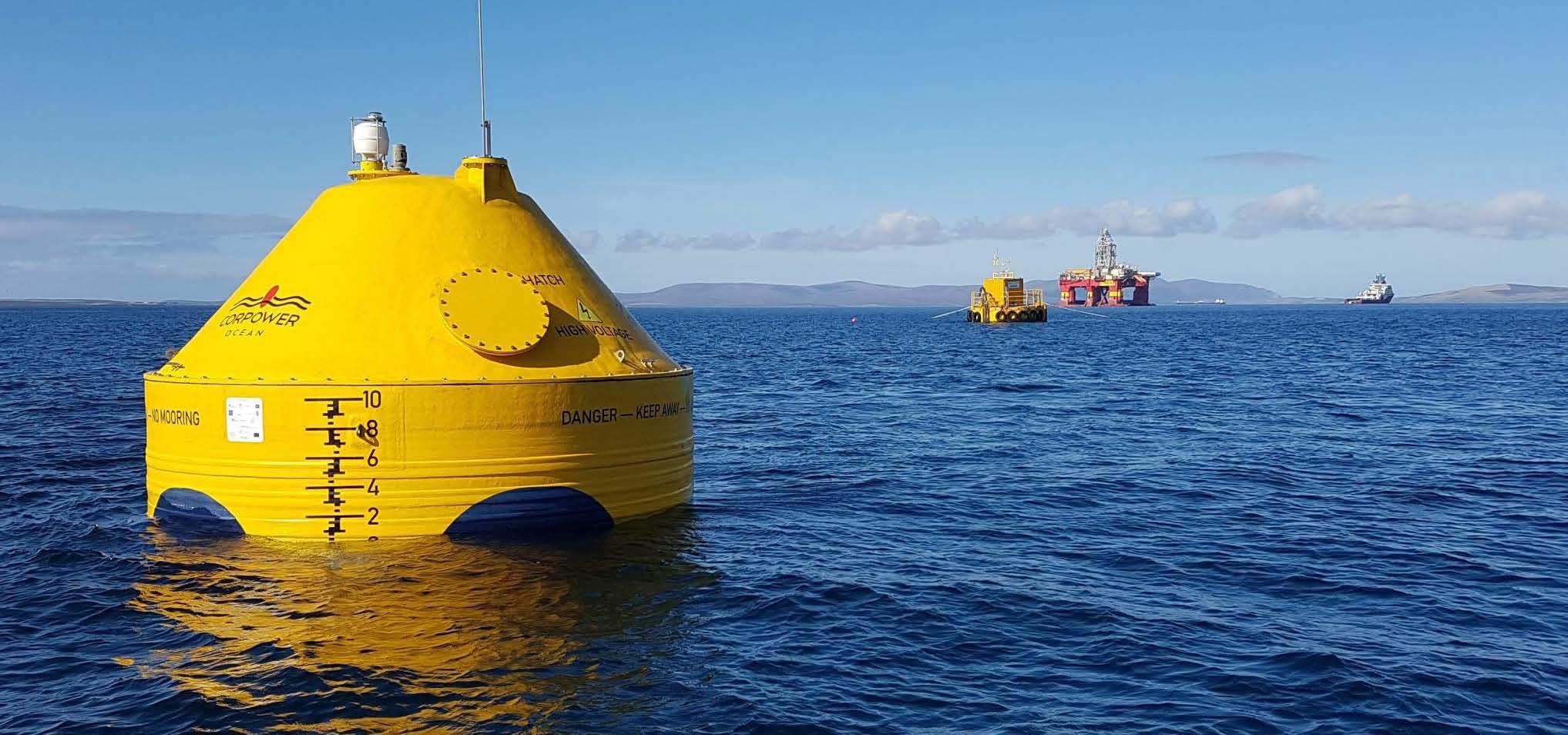
“The Government has an opportunity to embed UK content in marine energy projects deployed in its waters and around the world,
marine & Tidal
25

Hydrogen & CCS

THE FUTURE OF RENEWABLE ENERGY
Flotation Energy and Vårgrønn are leading the way in the development of offshore wind projects. Determined to support the global movement to Net Zero and sustainable energy consumption, our core strengths lie in finding and developing sites for floating projects in deeper waters globally. Together we have harnessed our expertise to deliver reliable oil and gas electrification and decarbonisation projects that will pioneer the future of renewable energy.

WOOD TO DEVELOP SPAIN'S MAJOR GREEN HYDROGEN PROJECT FOR CIP

Catalina will have a 500-megawatt electrolyser that will produce 84,000 tonnes per year
The Copenhagen Infrastructure Partners (CIP) fund has selected UK engineering firm Wood to develop a major green hydrogen facility in Spain. The Catalina project, to be built in Monegros (Teruel), plans to produce up to 84,000 tonnes of this sustainable fuel per year.
The ambitious project, which is expected to meet 15% of Spain's current hydrogen demand, will have an electrolyser with a 500-megawatt peak capacity. It will be powered by 1.5 gigawatts of purpose-built wind energy and solar energy.
Spain's energy transition
Wood will develop the entire project from its offices in Spain and the UK. Its President of Process & Chemicals, Giuseppe Zuccaro, says Catalina “is setting a global standard for large-
scale green hydrogen production projects and will support Spain's energy transition journey”. As he explains, the company will be able to combine its specialisation in hydrogen, its ability to execute complex projects and its strong presence in the region.
The Teruel project is one of five large-scale green hydrogen projects currently being developed by CIP in Europe. The fund, which has a portfolio of seven gigawatts of renewables in Spain, first announced the launch of the Catalina project in February 2022. Right from the start, the Danish fund formed an alliance with Enagás, Naturgy, Fertiberia and Vestas.
Green ammonia plant
According to information shared by the consortium, Catalina will connect Aragon
and Sagunto (Valencia) via a 221-kilometre pipeline that will transport green hydrogen to supply a state-of-the-art, newly built green ammonia plant operated by Fertiberia, with an annual capacity of 200,000 tonnes. The factory will produce 100% emission-free and sustainable fertilisers.
The hydrogen produced in Monegros will also be used to decarbonise other industrial processes and will be integrated into the natural gas grid. When fully operational, it will avoid the emission of up to 2.5 million tonnes of carbon dioxide per year.
The partners estimate that, until the project is commissioned, more than 5,000 jobs will be created in Aragon and Valencia during the development and construction phase, including indirect jobs and jobs created via a knock-on effect.
hydrogen & CCS
www.ogv.energy - Renewables Issue 7 26
SPONSORED BY
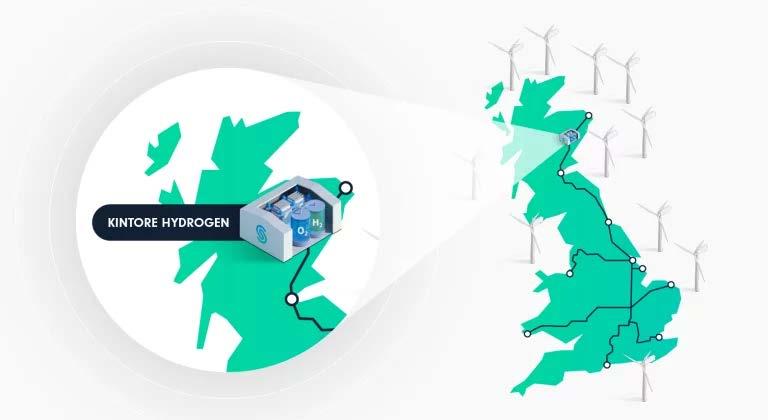
STATERA ENERGY SELECTS AKER SOLUTIONS FOR KINTORE HYDROGEN PROJECT'S 500MW FIRST PHASE
Statera Energy collaborates with Aker Solutions for the Kintore Hydrogen project, aiming to revolutionize the green hydrogen industry and sustainability.
Statera Energy has made a significant move in the renewable energy sector by appointing Aker Solutions as the owner's engineer for the inaugural 500MW phase of the Kintore Hydrogen project. This collaboration marks a pivotal step in the development of Statera's ambitious 3GW green hydrogen electrolyser project, aiming to leverage Aker Solutions' vast experience in green hydrogen and process industry expertise. The partnership is expected to enhance the project's frontend engineering design (FEED) phase, setting a solid foundation for this groundbreaking initiative.
Strategic Collaboration for Green Hydrogen Advancement
The decision to bring Aker Solutions into the project team underscores Statera Energy's commitment to achieving an optimal scheme for the Kintore Hydrogen project. Aker Solutions, known for its comprehensive expertise in the process industry and a strong track record in green hydrogen projects, will play a crucial role in steering the project's FEED phase. This collaboration not only signifies the merging of technical know-how and innovative engineering but also highlights the growing importance of green hydrogen as a sustainable energy solution.
Driving Sustainability and Innovation
Green hydrogen, produced through the electrolysis of water using renewable energy sources, represents a key component in the global transition towards sustainable energy. The Kintore Hydrogen project, with its massive 3GW capacity, is poised to become a cornerstone in the supply of green hydrogen, contributing significantly to reducing

alternative to fossil fuels.
Looking Towards a Green Future
The implications of the Kintore Hydrogen project extend far beyond its immediate environmental benefits. By setting a precedent for largescale green hydrogen production, the project promises to play a vital role in shaping the future of global energy consumption. The collaboration between Statera Energy and Aker Solutions not only paves the way for the successful realization of this project but also signals the growing momentum behind green hydrogen as a critical element in achieving a sustainable and decarbonized energy landscape.


hydrogen & CCS Hydrogen & CCS SPONSORED BY
carbon emissions. The partnership between Statera Energy and Aker Solutions is a testament to the industry's dedication to innovative solutions and sustainability, aiming to make green hydrogen a viable and competitive
27
Images courtesy of: stateraenergy.co.uk/projects/kintore-hydrogen
Unleashing the power beneath: Geothermal energy's rising role in the global energy transition

As the world strives to meet its growing energy needs while addressing the challenge of climate change, the need for renewable baseload energy sources is increasingly coming into focus. Geothermal energy is emerging as a front runner, providing a dependable and decarbonised solution to the world's energy requirements.
Although geothermal development dates back more than a century, it still occupies a niche market compared to other energy sources, but it’s potential is vast. With a pressing need to shift away from fossil fuels, geothermal energy offers a solution that delivers power day or night, rain or shine, with smaller footprints and consuming fewer raw materials than other renewable technologies.
Technological advancements
The convergence of several key factors has fuelled the rapid growth of the geothermal market. The increasing momentum behind the energy transition, coupled with geothermalspecific legislation and the demand for renewable baseload power, has created a

 By Mike Adams at Elemental Energies
By Mike Adams at Elemental Energies
fertile ground for investment and expansion. In Europe and North America in particular, we are witnessing a surge in both power generation and district heating systems powered by geothermal energy.
But geothermal has been around for much longer than the green revolution. In places such as Italy (1913) and New Zealand (1958), tapping the energy potential of geothermal was a logical and straightforward way to get access to consistent baseload power.
As we move into the 21st century, the recognition of geothermal potential in the global energy transition has spurred rapid evolution within the sector. This evolution has been marked by substantial investments in innovative technologies aimed at enhancing production efficiency, particularly at lower temperatures, and tapping into more common hot underground rocks. These technological advancements, developed over the past two decades, enable commercial production at increasingly lower temperatures and expand the scope of power generation to include non-hydrothermal rock formations. Such innovations are pivotal in broadening geothermal market reach and solidifying its role in the energy transition.
28 www.ogv.energy - Renewables Issue 7

Sector synergies
The transition to geothermal requires a concerted effort from both the public and private sectors. Drawing from the technical expertise of the oil and gas industry, companies are investing in the development of dedicated geothermal teams and infrastructure. At Elemental Energies we have been at the forefront of geothermal innovation, actively supporting energy companies, industry bodies, regulators and financial institutes with geothermal studies and campaigns since 2017, deploying our subsurface and wells specialists alongside project delivery teams.
We are passionate about the essential role of geothermal energy in achieving the 2050 new zero ambitions. CEO, Mike Adams, and Head of Decommissioning and Low Carbon, Julie Copland, recently attended the GeoTHERM 2024 event in Offenburg, Germany, participating alongside the Scottish Development International delegation. It was a platform to showcase the latest advancements in geothermal technology, including exploration techniques, drilling
technologies, and efficient power generation methods. These advancements are vital for improving the efficiency and cost-effectiveness of geothermal energy production.
Sustainable and scalable strategic partnerships
Some of the themes at this year’s event included the key role that geothermal, and specifically deep-geothermal energy, will play in achieving decarbonisation goals. In addition, operators and the supply chain alike were keen to discuss well construction challenges often encountered in geothermal drilling.
We are excited by the potential of geothermal energy to transform our race to net zero.
The technical nature of well construction, coupled with limited supply chain scale, are risks that must be addressed if geothermal is to achieve its full potential. We believe this can be delivered through scaling global strategic partnerships, innovating financing mechanisms, and working closely with stakeholders to promote the acceptance of deep-geothermal projects, with collaboration and education being essential in building trust and understanding within communities.
We are excited by the potential of geothermal energy to transform our race to net zero. To realise this vision, scaling the geothermal supply chain, advancing technology, and enhancing well delivery are paramount. In order to do this, we must invest in the next generation of geothermal technical professionals and focus our attention toward one of the most exciting forms of renewable energy.



GEOTHERMAL SPONSORED BY
Geothermal
29

www.infinity-partnership.com
Infinity Partnership: Your Partner in Business
Infinity Partnership is an award-winning, multi-disciplinary accountancy and business advisory practice, with a proactive approach to customer service.
Infinity has been a five-time winner at the British Accountancy Awards and has been a three-time finalist at the Scottish Accountancy Awards in recent times.
Saipem (SAPMF) Wins Offshore Carbon Capture Projects in the UK
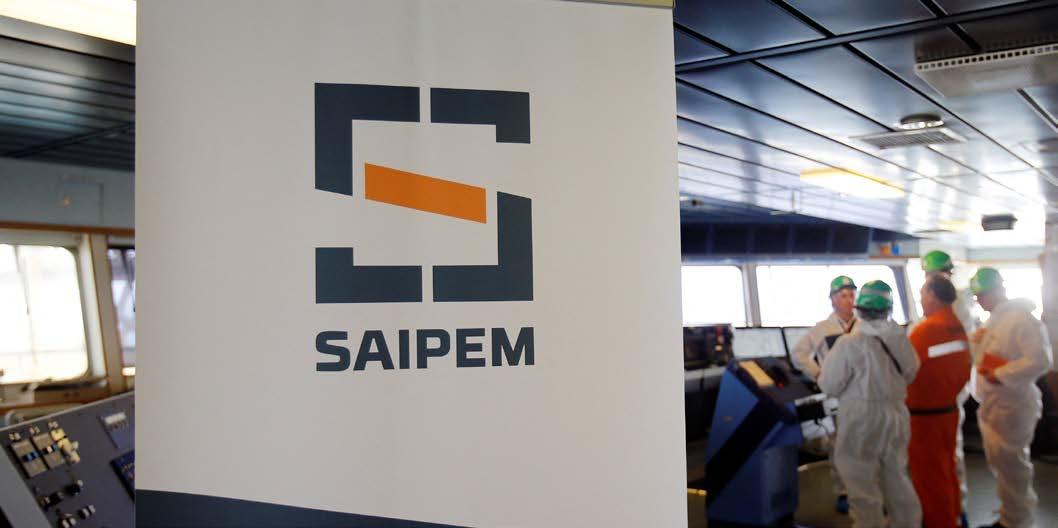
Saipem S.p.A has signed a letter of intent (LOI) related to two projects to develop offshore carbon dioxide transportation and storage infrastructure for the East Coast Cluster in the United Kingdom. The company has been awarded the Northern Endurance Partnership (NEP) and Net Zero Teesside Power (NZT) projects.
NEP is a joint venture among BP, Equinor and TotalEnergies. NZT Power is a joint venture between Equinor and BP.
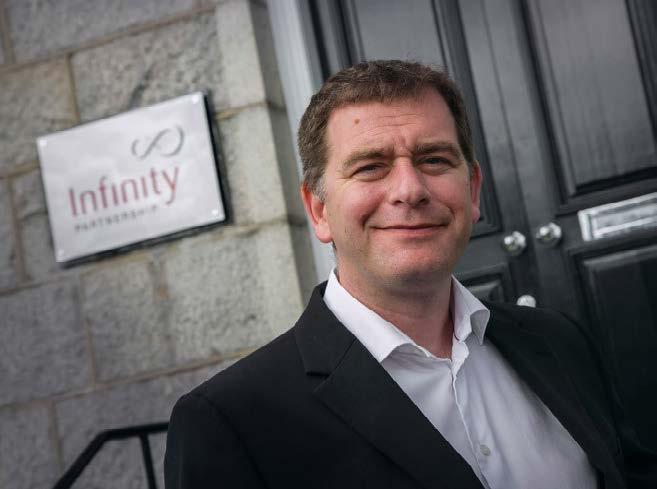
As part of the project, Saipem will be responsible for the engineering, procurement, construction and installation of a 28" and 145 Km offshore pipeline for the NEP project. It will also be accountable for the associated landfalls and onshore outlet facilities of the same project. For the NZT project, Saipem’s scope of work covers the engineering, procurement, construction and installation of the water outfall. The final award to Saipem is contingent upon receiving relevant regulatory clearances along with positive final investment decisions (FIDs) by the projects and the government of the United Kingdom, planned for September 2024 or earlier.
Upon completion, the two projects will serve the East Coast Cluster in Teesside. The carbon capture projects are expected to have a transportation and storage capacity of 4 million tons per year, beginning 2027.
Saipem’s flagship vessel Castorone will carry out the offshore pipeline operations. The operations near the shore will be performed by Castoro 10, the company’s shallow water pipelay.
SAPMF states that the LOI solidifies its position in the low and zero carbon segments, highlighting its engineering and technological expertise, along with its core competencies and assets across the Carbon Capture and Storage value chain.
Renewables for Subsea Power (RSP) project completes 12-month milestone
A groundbreaking ocean energy project which has combined wave power with subsea energy storage to power subsea equipment has now completed a 12-month test programme at sea and will end this Spring.
The final phase will commence shortly and will include removing all equipment from the site, ahead of inspection and clean down onshore in Orkney and at Verlume’s operations facility in Dyce, Aberdeen.
The £2million Renewables for Subsea Power (RSP) project connected the Blue X wave energy converter – built by Edinburgh company Mocean Energy – with a Halo underwater battery storage system developed by Aberdeen intelligent energy management specialists, Verlume.
The industry-backed project, located 5km east of Orkney Mainland, has shown how green technologies can be combined to


provide reliable and continuous low carbon power and communications to subsea equipment, offering a cost-effective future alternative to umbilical cables, which are carbon intensive with long lead times to procure and install.
In recent months energy majors TotalEnergies and Shell Technology – Marine Renewable Program have joined project leads Mocean Energy and Verlume in the pan-industry initiative, alongside PTTEP, the Thai national oil company, Serica Energy, Harbour Energy, Baker Hughes, Transmark Subsea, and the Net Zero Technology Centre (NZTC).
contracts
contract awards SPONSORED BY
30 www.ogv.energy - Renewables Issue 7
Aker Solutions to support the industrial transformation of Mongstad

Aker Solutions has been awarded a contract by Equinor to carry out a feasibility study for its Mongstad Industrial Transformation project in Vestland county on the west coast of Norway.
The study aims to identify solutions to significantly reduce CO2 emissions from the existing refinery and transform the site into a new low-carbon industry cluster whilst demonstrating safe, technical, and economically feasible solutions.
The scope includes a new greenfield facility which will be developed to produce blue hydrogen from natural and refinery fuel gas, along with a carbon capture and export solution. It also covers a new facility to produce sustainable aviation fuel (SAF) from municipal solid waste with more than 70 % reduced emissions.
Aker Solutions’ consultancy will deliver a feasibility study for both new and existing facilities, integrating brownfield, greenfield and third-party technologies to examine options for future operations. Consultants and engineers from Aker Solutions’ Oslo, Bergen and Mumbai operations are involved, delivering expertise in onshore and downstream project execution, gasification, CO2 storage, brownfield, and integration.
“We are excited to support Equinor on this truly transformational study, maximizing industrial synergies to produce low-carbon solutions and sustainable fuels at a time when decarbonization is very high on the agenda,” said Roddy Macpherson, senior vice president, consultancy at Aker Solutions.
“For decades, we have worked with customers and partners to minimize
OSSO marks geothermal milestone with trio of
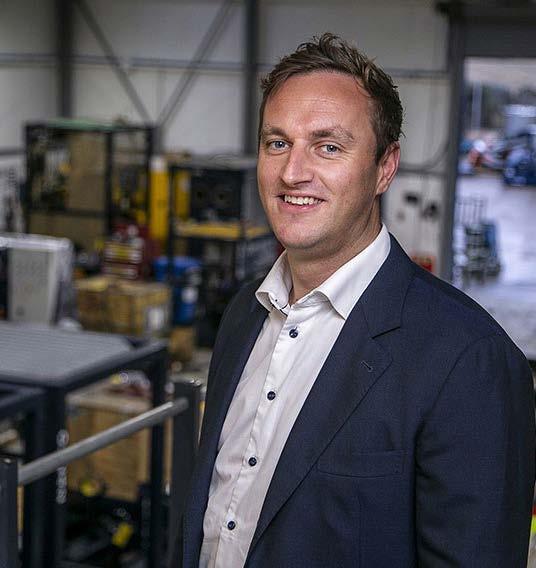
OSSO, the specialist provider of fluid temperature control and separation solutions, has been awarded three individual
commercial uncertainty and enable informed decision-making for first-of-akind projects across the globe. Building on our strong engineering and construction expertise, and our understanding of the evolving energy system and landscape, we aim to drive change at pace for our customers. The Mongstad study will help to further accelerate Norway’s energy transition, transforming the country’s only remaining oil and gas refinery to create energy sources of the future.”
Mongstad is a medium sized refinery in Europe, emitting around 1.7 million tons of CO2 emissions annually. Equinor aims to significantly reduce emissions the Mongstad refinery.
Study work is ongoing.
mud-cooling project wins
contracts representing a combined sevenfigure sum. The award wins will see OSSO deploy its high-volume mud cooler technology to key geothermal projects within Europe.
Chosen for its extensive drilling knowledge and proven technology, OSSO’s mud cooling offering will provide clients with a unique advantage in reducing downhole temperatures. For one of the contracts, OSSO is providing services for Eavor's groundbreaking Eavor-Europe geothermal project, the world's first commercial implementation of a closed-loop geothermal energy extraction system. This project will generate 8.2 MWe and mitigate approximately 44,000 tCO2e GHG emissions per year, providing clean energy to an estimated 20,000 homes.
James Scullion, CEO of OSSO said: “These contract wins are a significant milestone
for OSSO as we continue expanding our global footprint in geothermal energy. Our decades of expertise in high-pressure, high-temperature drilling and proven mud cooler technology have uniquely positioned us to support the geothermal sector and we have made significant investments to redeploy our existing technology and create a specialist geothermal offering that can be tailored to the specific needs of each individual customer.”
With a strong focus on health and safety, the company will aid the operators of each project in maintaining a manageable temperature in the mud system during drilling. This will create a safer environment for rig crews, but also minimise operational delays and extend the longevity of downhole tools and rig equipment in high-temperature applications.


contracts contracts SPONSORED BY
31

www.westwoodenergy.com
Westwood Global Energy Group
Westwood Global Energy Group are specialist providers of detailed market intelligence for the offshore energy sector, covering; offshore rigs, production facilities, subsea equipment, subsea services, offshore marine and offshore renewables and power.
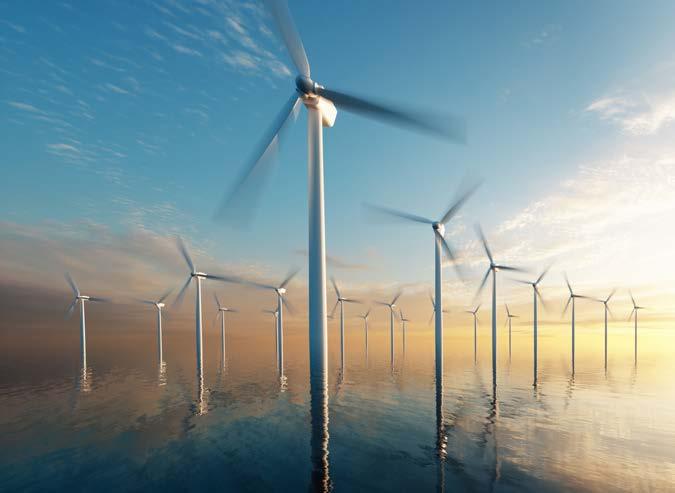
2024 is a time for action: six themes that will shape the low-carbon Hydrogen and CCUS industries in Northwest Europe
Despite leadership in its hydrogen strategies and goals, the European lowcarbon hydrogen and carbon capture, utilisation and storage (CCUS) industries have in the last few years suffered from inertia. The US on the other hand has attracted significant investor interest. 2023 was therefore a critical year for the region to ensure it could also entice investors; and it did not disappoint. There were a raft of policy and funding announcements both at an EU and country level as well as significant project progress. But as we reflect on 2023, it’s important not to look back through rose tinted glasses.
While progress has been made, some deadlines were taken to the wire, while others have been delayed. In the UK, the government left it to the last few weeks of the year before releasing promised plans for the expanded Track-1 and Track-2 Cluster Sequencing Process. For UK hydrogen, the results of the first Hydrogen Allocation Round (HAR1) were announced in late-December 2023, with offers of contracts totalling only half of the planned 250MW capacity. The EU also saw delays, with key announcements expected in 2023 slipping to 2024; the EU industrial carbon management strategy and announced winners of Germany’s first tenders for hydrogen imports scheme being prime examples.
On reflection, it would seem the key theme of 2023 for the hydrogen and CCUS industries was patience. Industry and project developers have waited patiently for key announcements that will help shape their projects and the industry. The question for 2024 is, will that patience continue? In this insight, Westwood identifies the six key themes that will shape 2024.

 Author: Jun Sasamura, Senior Analyst – Hydrogen Westwood Global Energy Group
Author: Jun Sasamura, Senior Analyst – Hydrogen Westwood Global Energy Group
1. Key government strategies and regulations should be signed off to ensure continued momentum
In the EU, the European Commission is expected to announce details on its industrial carbon management strategy and 2040 climate targets. The targets will bridge the gap between the 55% reduction in greenhouse gas (GHG) emissions by 2030 and carbon neutrality by 2050. Germany’s carbon management strategy is expected to be released in 2024, which amongst other things will remove a ban effectively prohibiting CCS.
While government targets for hydrogen production are in place, other regulations expected this year are key to see continued progress from project developers. The International Maritime Organization (IMO) plans to finalise its guidelines on the use of hydrogen and ammonia as a shipping fuel
in December 2024. The decision is eagerly anticipated for engine manufacturers, shipbuilders and operators, with Wartsila and MAN planning to make their ammoniapowered engines commercially available as early as the start of this year, and companies like Yara, who have an ammonia container ship in development to travel between Norway and Germany for the start of 2026.
2. Continued announcements and updates to funding mechanisms will demonstrate necessary commitment
In the UK, the results of the CCUS Track-1 Expansion Process and confirmation of Track-2 anchor projects are to be announced while the second Hydrogen Allocation Round (HAR2) applications will be reviewed and shortlisted in 2024, with final award of contracts expected in 2025.
The winners of the €800mn European Hydrogen Bank pilot auction that opened in November 2023, offering an “auctions-as-aservice” mechanism, are to be announced in April 2024; with a second auction planned to open in the spring. France’s updated hydrogen strategy lays out plans to spend €4bn on subsidies in a CfD-style auction, with first call for tenders of 150MW expected to launch at the start of this year.
3. Key projects need to progress to construction and demonstrate successful operation to ensure public confidence
Projects due to start operation will be carefully observed, while those in advanced stages of development need to progress to FID to demonstrate progress and investment in the industry. Any failures will impact the confidence of (and in) the industry.
& ANALYTICS SPONSORED BY
STATS
& analytics
Stats
32 www.ogv.energy - Renewables Issue 7

When it comes to CCS, the Northern Lights project in Norway, which is due to be online before the end of the year, will be crucial in successfully demonstrating a number of industry firsts, including cross-border transport of industrial volumes of CO2 for permanent storage. Elsewhere Climework’s Mammoth Direct Air Capture (DAC) facility in Iceland could also be operational in 2024, helping to underline DAC’s potential in Northwest Europe’s own carbon management strategy.
Having reached a pivotal milestone in the project development timeline, the 11 projects awarded funding as part of the UK’s HAR1 will be an important test to gauge the much-needed progress of the European hydrogen sector. Progress, as seen for H2 Energy’s 1GW project in Esbjerg receiving environmental approval, will be crucial to demonstrate the scaling potential for green hydrogen projects.
4. The scope and scale of CCUS markets will increase through further carbon storage licence awards and progress in circumventing the London Protocol
Results from Denmark’s onshore Carbon Storage Licensing Round are anticipated while Norway and the Netherlands are expected to continue the ad-hoc approach to licences. Following the success of the UK’s first licensing round, subsequent rounds are expected, although 2024 may be too early considering the North Sea Transition Authority (NSTA)’s current inbox.
Further progress on bilateral agreements to circumvent the London Protocol, which prohibits the transfer of CO2 between countries for permanent storage, is expected. This will be important in improving both the internationalisation and commercial potential of the industry.
5. More focus on hydrogen end-use demand sectors that demonstrate greater potential and attention from policymakers is expected
2023 was a difficult year for some hydrogen use cases. Lack of low-carbon hydrogen supply and profitability saw developers steer away from hydrogen fuelling for cars, with companies like Everfuel closing all of Denmark’s filling stations last year. Home heating also took a hit, with the UK’s Whitby and Redcar hydrogen heating demonstrations cancelled after public opposition.
The role of hydrogen in industrial decarbonisation has demonstrated greater potential, with expected progress to be made in maritime transport and aviation as well. Funding for green steel projects around Europe has occurred in Sweden, France, Belgium and Germany, with German steel-maker Salzgitter committed to start converting its steel production facilities to run on green hydrogen alongside electric arc furnaces from 2025. FuelEU Maritime and ReFuelEU should provide a catalyst for the use of hydrogen-based fuels for shipping and aviation, with specific targets effective from 2025.
6. There is political uncertainty surrounding upcoming elections in 2024 – the results of which could play an important role in achieving progress
Around 70 countries globally, with more than half the global population, could be heading to the polls in 2024. The outcome of EU elections in June will be important for energy policy implementation as climate targets for 2030 approach. Elections in the UK could promote a greener agenda, with a potential Labour government supporting more ambitious renewable energy and green hydrogen production targets. Dynamics elsewhere could also influence Europe’s attractiveness as an investment opportunity; the anti-climate rhetoric in the US election, due at the end of the year, is one such example.
Overall we do not expect significant shifts in near term climate ambitions or targets, but the question of how proactive governments will be in an election year on continuing to implement the necessary regulations and funding mechanisms, remains to be seen. Westwood will be carefully monitoring the industry to see how 2024 evolves.
Westwood’s new Hydrogen market intelligence solution, initially focused on Northwest Europe, is now live. Stay on top of the evolving market opportunity and assess individual projects and pipeline risks. To find out more, contact sales@westwoodenergy.com



STATS & ANALYTICS SPONSORED BY Stats & analytics
33
SolarEX 2024
04-06 April 2024
Istanbul, Turkey
RNG Forum
10 April 2024
Drummondville, Canada
Energy Tech Summit
10-11 April
Bilbao, Spain



Your Trusted Global Travel Partner

Approaching the environmental impact of travel within the decommissioning process



World Future Energy Summit
16-18 April
Abu Dhabi, UAE
Pulse
17-18 April
Madrid, Spain

26TH WORLD ENERGY CONGRESS
22-25 April 2024
Rotterdam Ahoy, Rotterdam, The Netherlands
Solar & Storage Live UK 2024
1-2 May
Birmingham, UK
IEEE PES Transmission & Distribution Conference & Exposition
6-9 May 2024
Chicago, USA
Offshore Technology Conference
6 May 2024
Houston, USA
EcoMotion 2024
07-09 May 2024
Tel Aviv, Israel
E-TECH Europe 2024
07-08 May 2024
Bologna, Italy
ACT Expo
20-23 May 2024
Las Vegas, Nevada, United States
Japan Energy Summit & Exhibition
3 June 2024
Tokyo, Japan










The decommissioning and repurposing of existing oil and gas assets is a rapidly growing market. With the billion-pound industry becoming more prevalent year on year, the focus on environmental impact has become a focal point across the industry.
The process of decommissioning is not without environmental risks and comes with its own GHG footprint, such as water pollution, waste disposal and extensive travel logistics to complete the project, mitigating the impact is a key focus for many businesses.
The travel logistics of these projects alone are significant, and in an environment of growing sustainable reporting directives, in need of addressing. Finding a partner, who can offer reduction solutions, as well offset solutions to compensate for the unavoidable carbon footprint of travel logistics is increasingly important. By working with a partner such as ATPI Halo, decommissioning projects can use the measure> reduce> compensate methodology, helping them to commit to sustainability and cost targets, inline with their organisations’ goals for truly sustainable travel, irradicating the stress of environmental impact from shift rotations. Where reducing rotational travel may not be possible, purchasing Sustainable Aviation Fuel (SAF) through ATPI Halo can be solution to
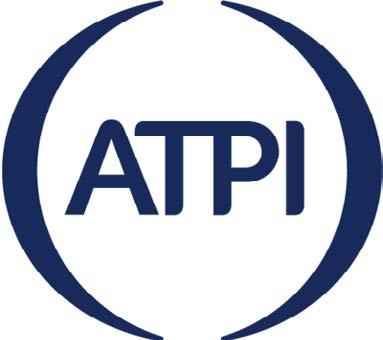
achieve a percentage of immediate in-sector CO2e emissions reduction. For the residual footprint ATPI Halo’s portfolio of carbon offset projects are selected for their quality, integrity, and effectiveness in addressing global challenges of environmental impact management. Correlation with the UN’s 17 Sustainable Development Goals (SDGs) ensures a balance of the three dimensions of sustainable development: economic, social, and environmental.
ATPI has a legacy of supporting the energy community with its travel requirements. Complex logistics are something our consultants deal with on a daily basis. Over the years we have built up a great deal of experience at both an operational level, as well as understanding how important data is when reviewing these logistics, from a cost, Duty of Care/Well-being and sustainability/ carbon reporting perspective. The data we gather during the booking process is critical to our clients when meeting environmental directives and completing audits, ensuring compliance is at the forefront of everything that ATPI Halo does.

As decommissioning progresses, be that the closure and break-up of projects and assets, or even preparing them for a potential new future in the carbon storage sector, ATPI will be ready to support.

www.ogv.energy/events VIEW ALL EVENTS AT UPCOMING GLOBAL EVENTS
April - June 2024
2024 To find out more, please contact ATPIEnergyTravel@atpi.com
34


Virtual Data Rooms
Smart and secure virtual data rooms to support information sharing and regulatory compliance activities across the Energy sector.
Global reach
Significantly reduce decision making time and environmental footprint by promoting assets to a global audience.
Secure and robust access control
Keep user permissions, access and privileges under control. Increase efficiency and security by streamlining account and group management.
Keep your data under control.
Administration Dashboard
Manage permissions for users, groups and documents in real-time.
Multi-access
Unlimited number of users and companies.
Flexible invoicing
Applications, data and software support
Gain access to multiple technical platforms from anywhere and benefit from Cegal’s unique know-how during the duration of your data room.
Quick deployment
Configure and provision data rooms in minimum time, from anywhere in the world.
Confidentiality and security
Protect confidential data against unsolicited viewing. Secure access through multi-factor authentication.

Pay-as-you-use model, invoiced on a weekly or monthly basis.


Scan the QR code to learn more.
Customization
Configure and customize to fit your needs. Create a familiar collaborative workspace for all users.
cegal.com
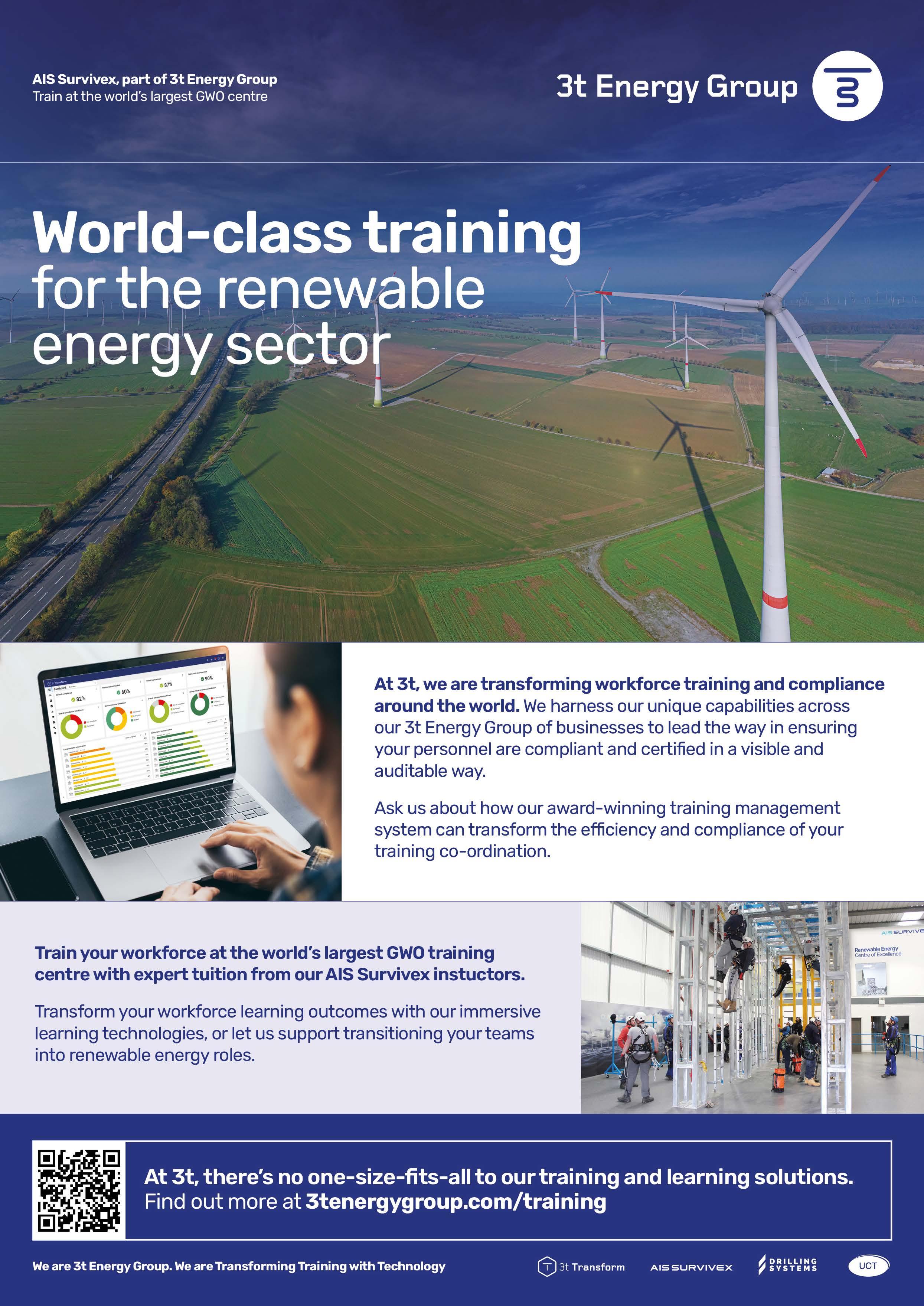




















































 By Mike Adams at Elemental Energies
By Mike Adams at Elemental Energies














 Author: Jun Sasamura, Senior Analyst – Hydrogen Westwood Global Energy Group
Author: Jun Sasamura, Senior Analyst – Hydrogen Westwood Global Energy Group




























